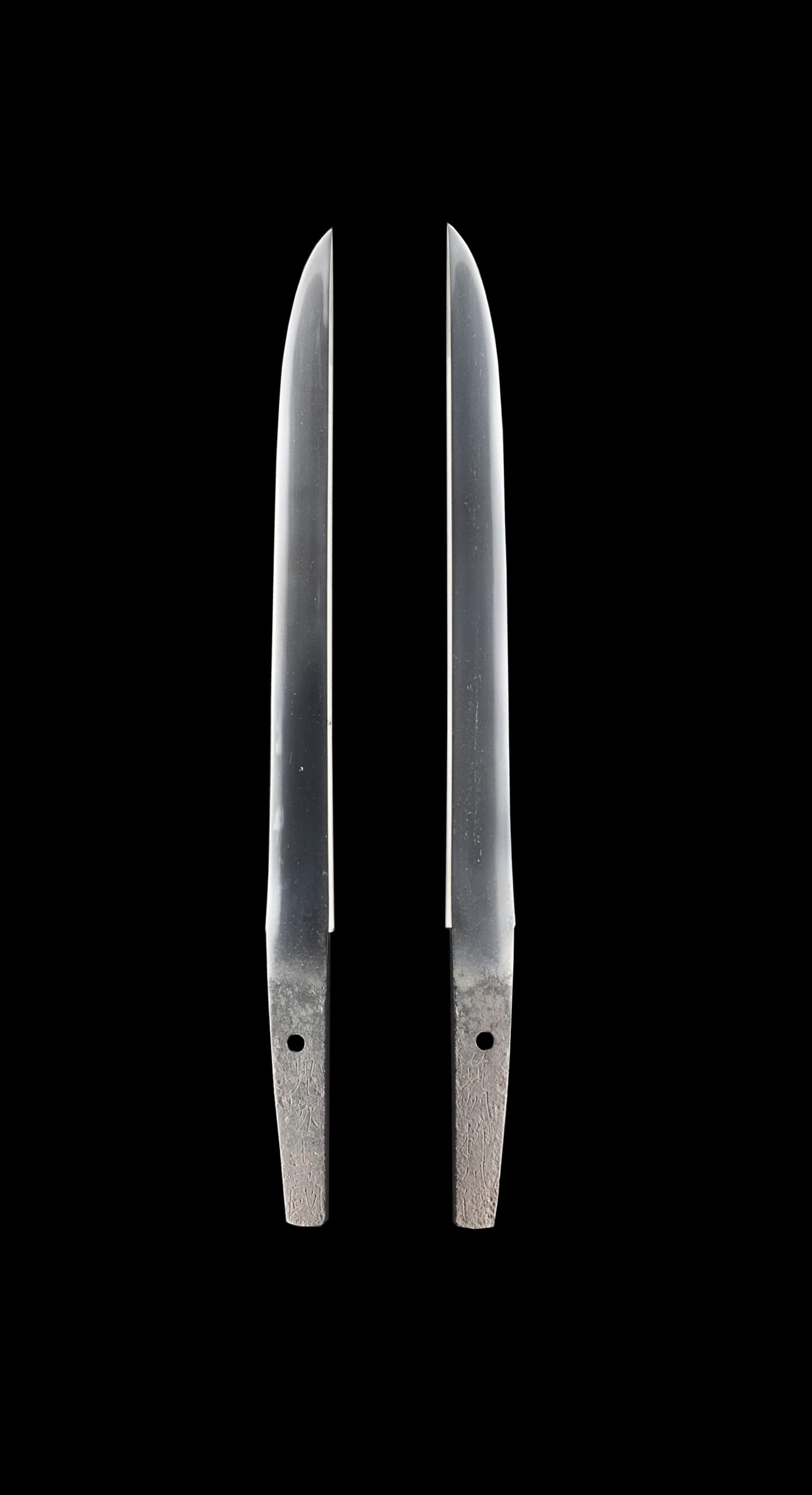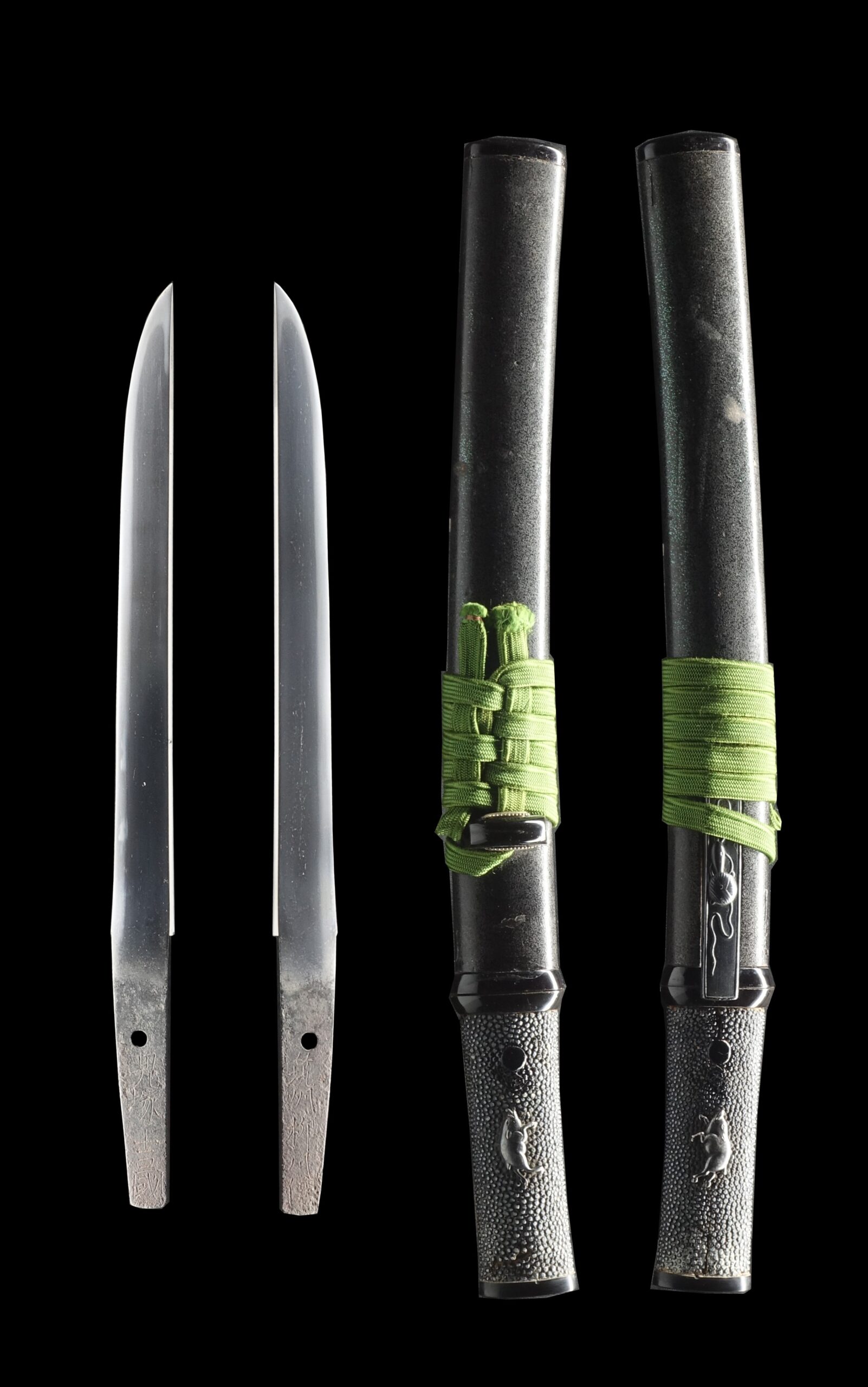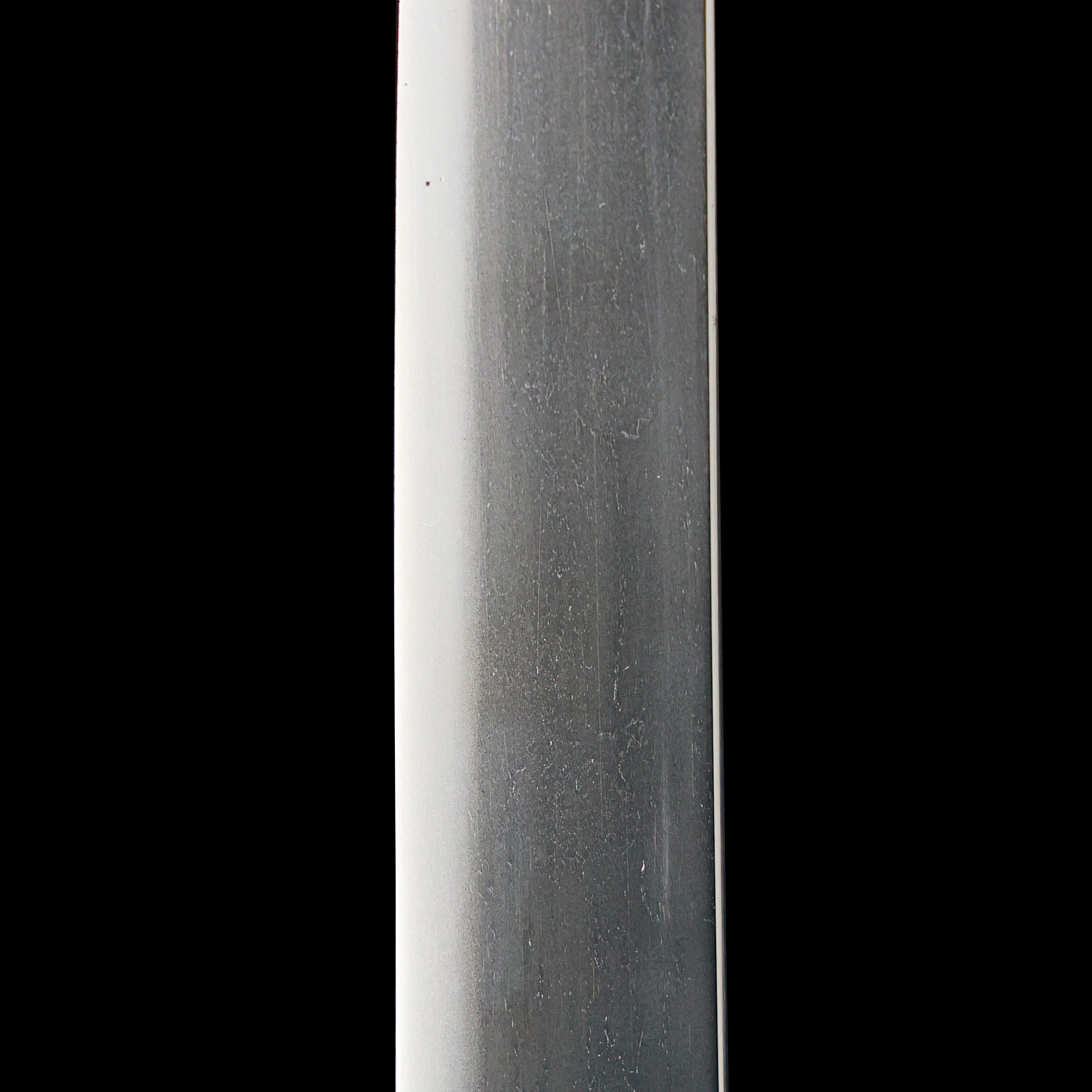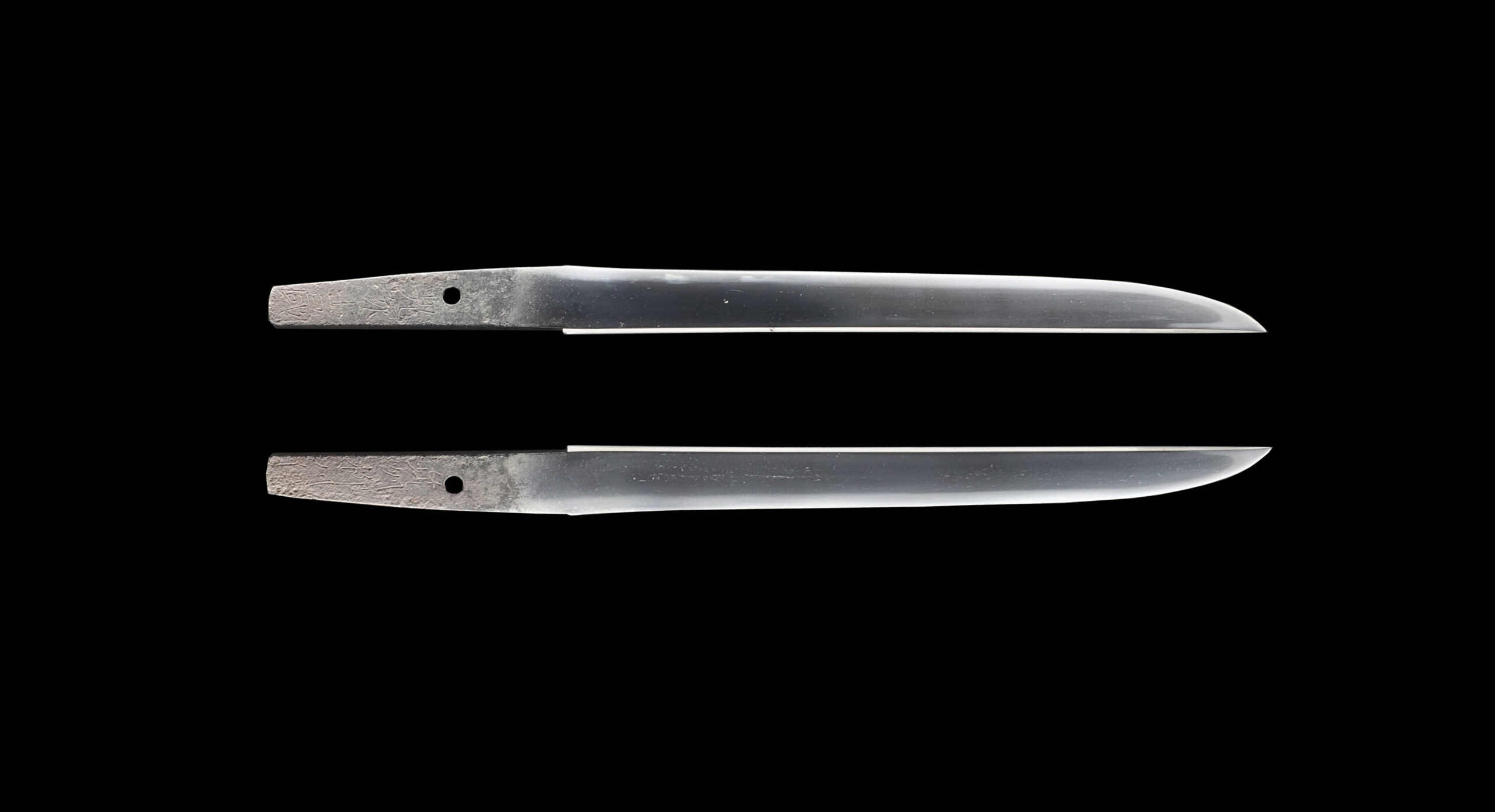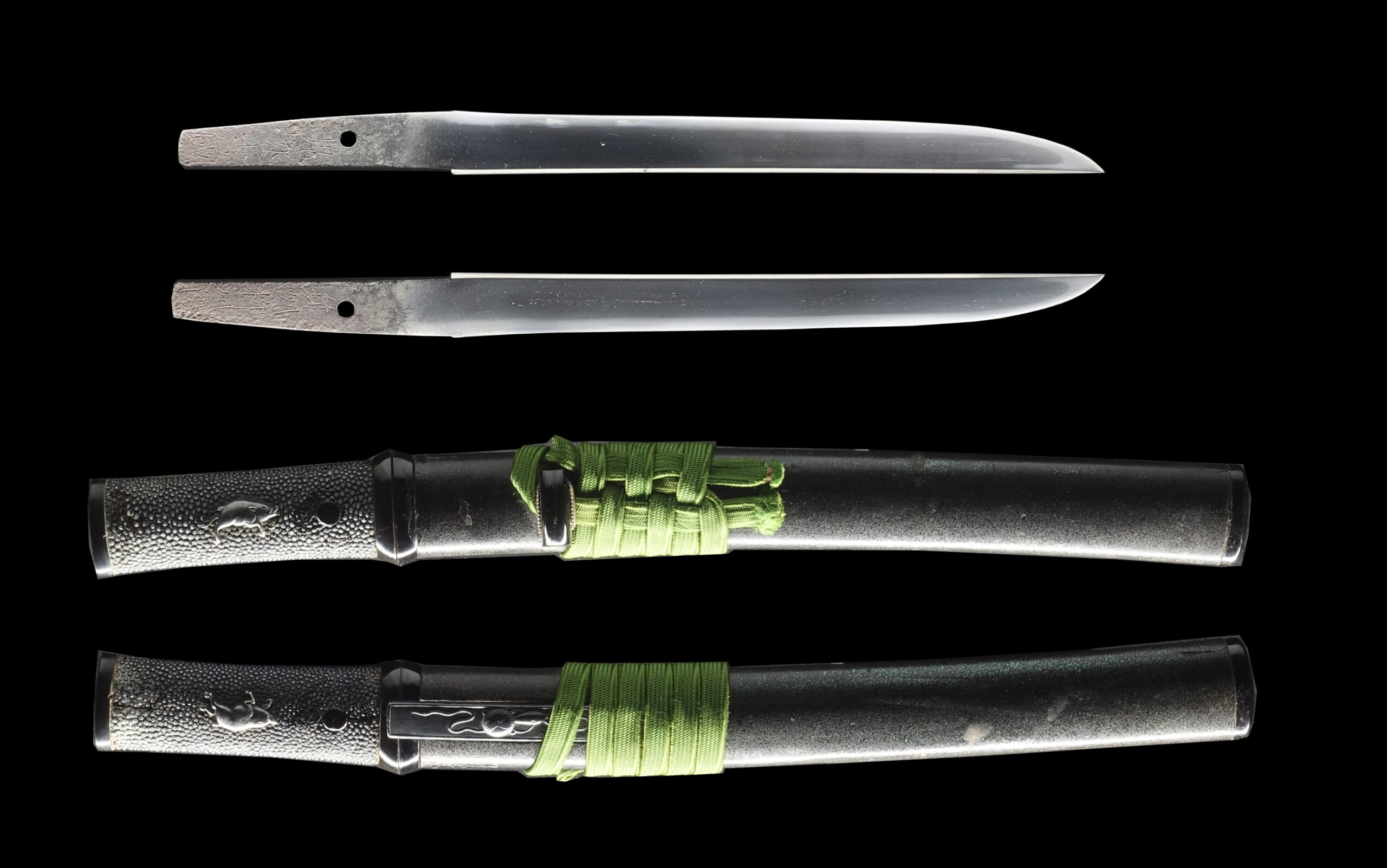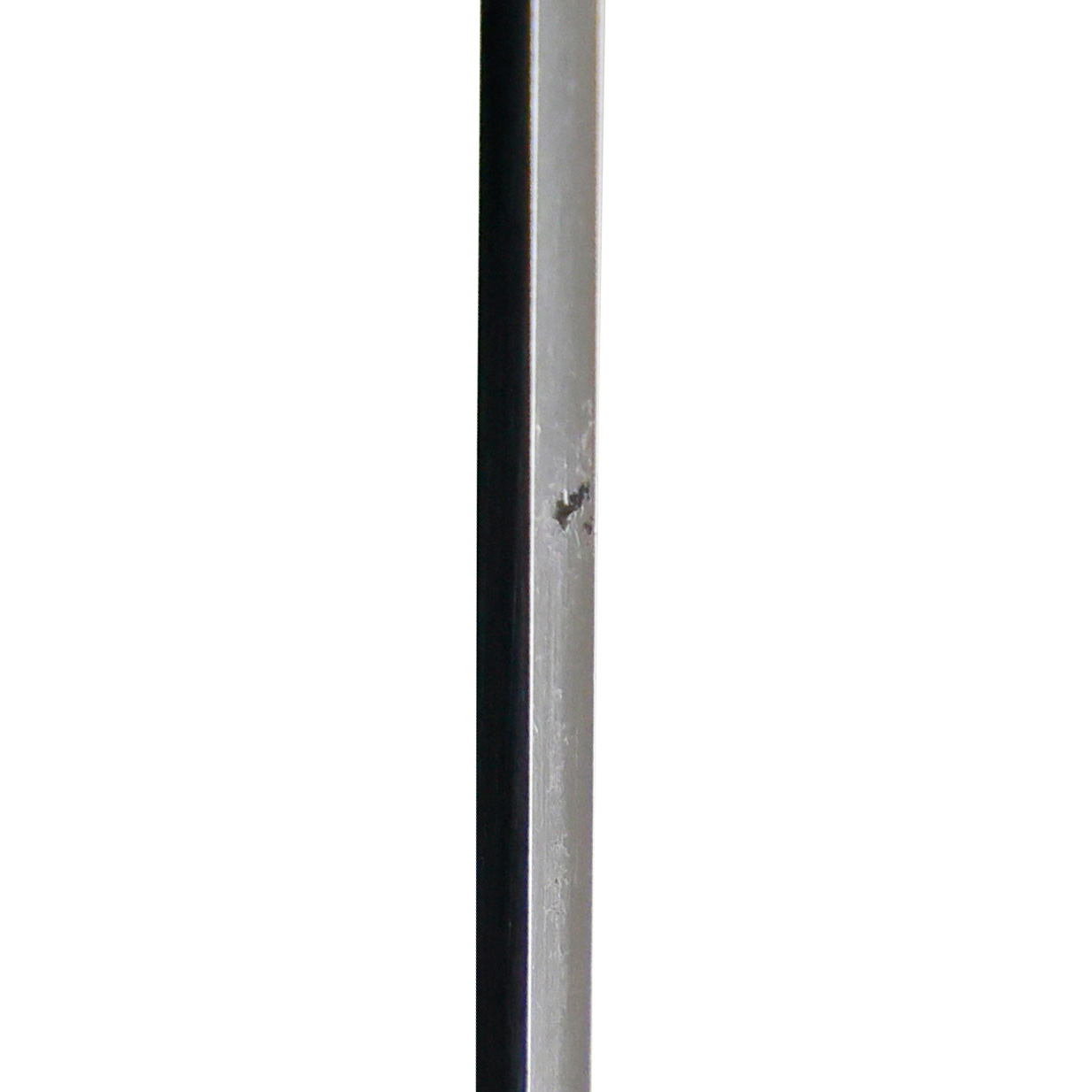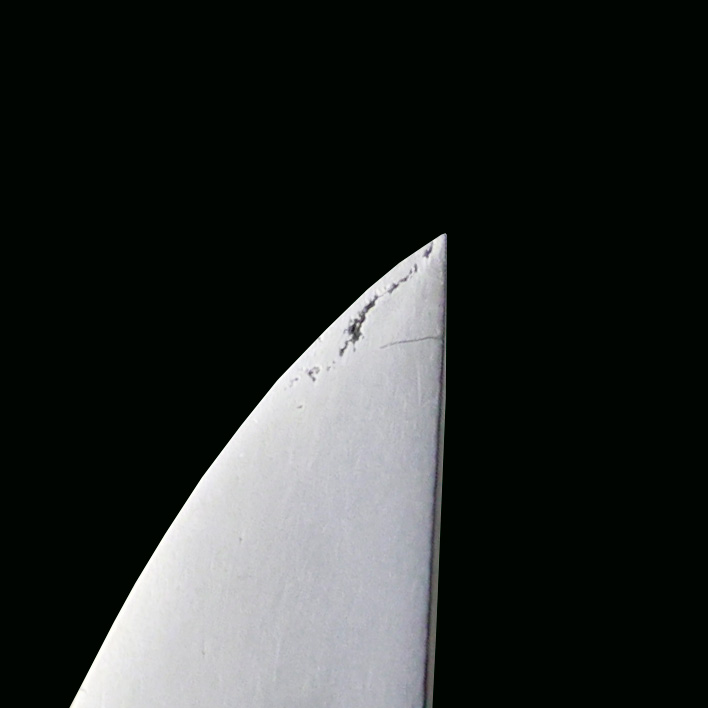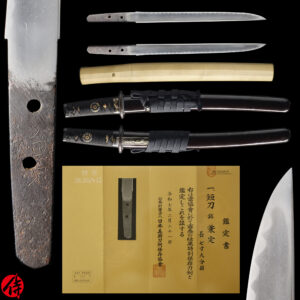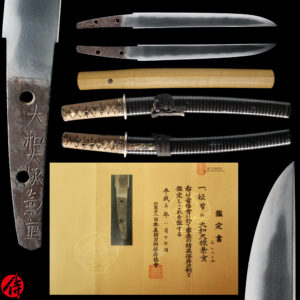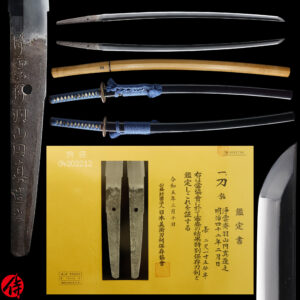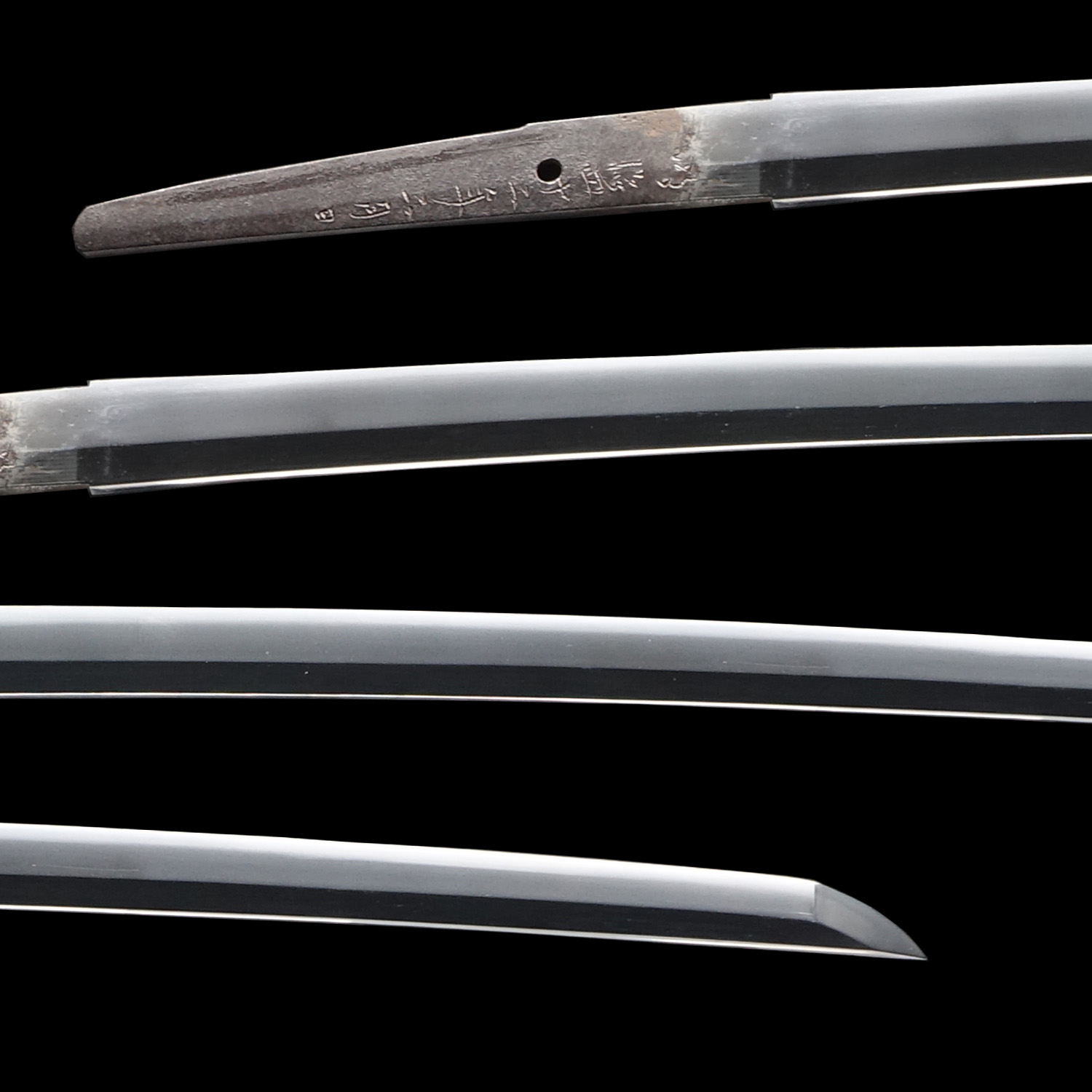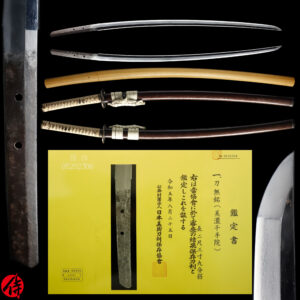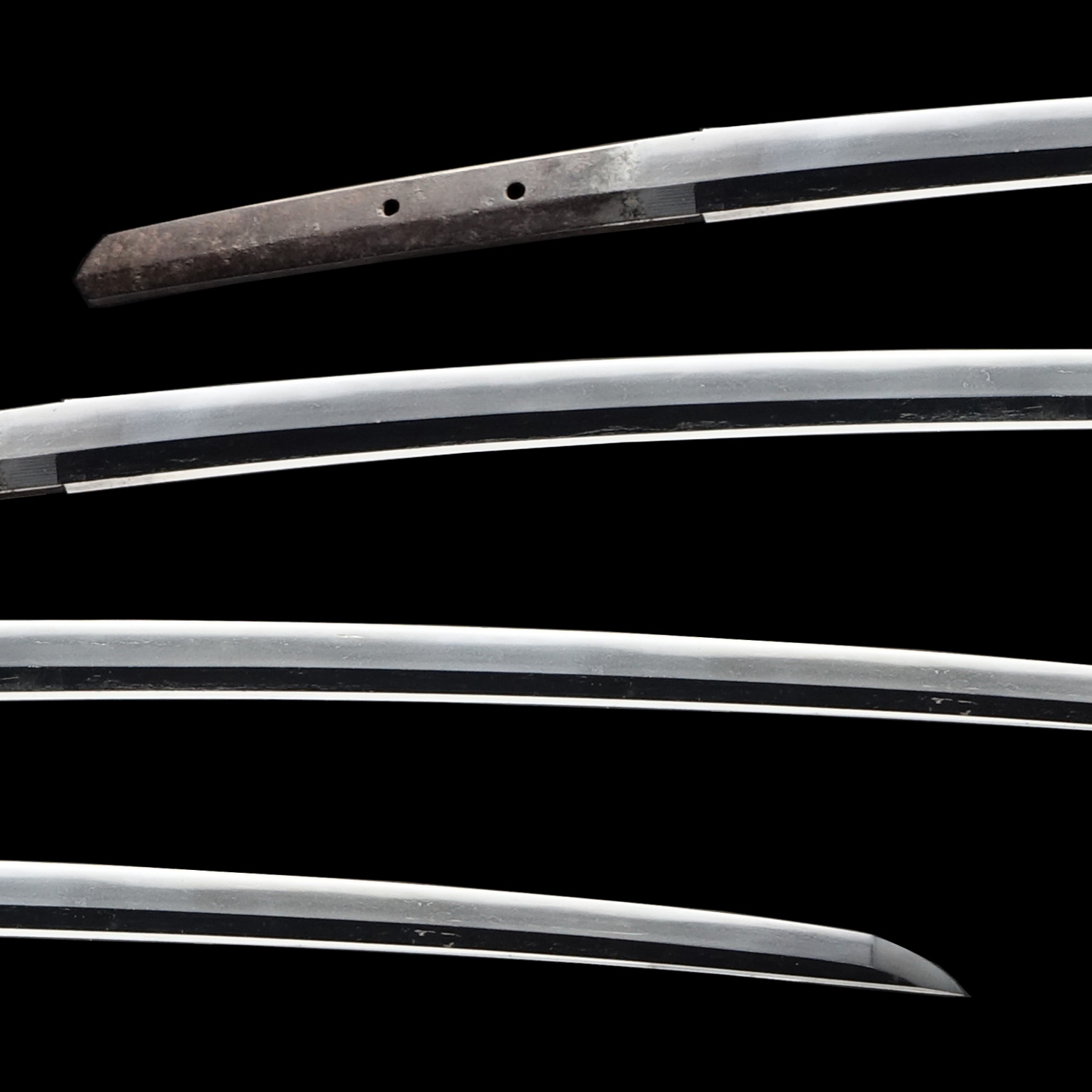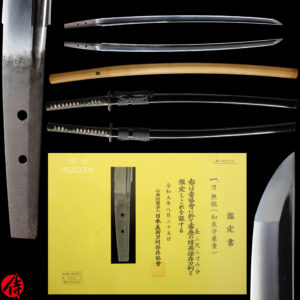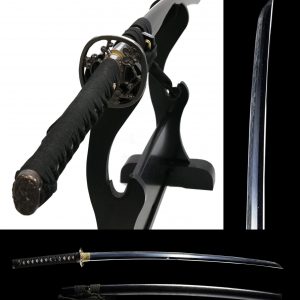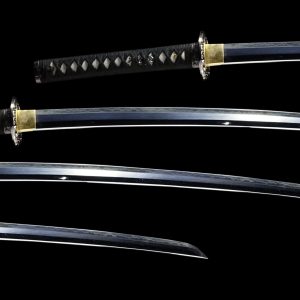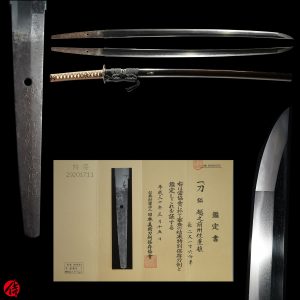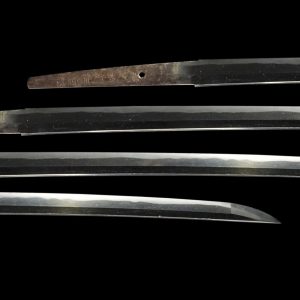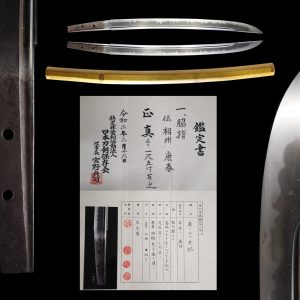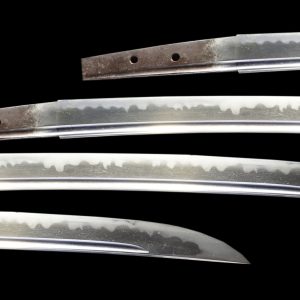Antique Japanese Sword Tanto Signed by Onizuka Yoshikuni with NBTHK Hozon Certificate
【Description】
This blade was signed by Onizuka Yoshikuni (鬼塚吉国), a renowned swordsmith who was especially active during the early Edo period (1615–1624) in Chikugo Province (present-day Fukuoka Prefecture). He was considered one of the most highly regarded swordsmiths in the region during that time. This particular blade was forged while he was working in Chikuzen Province, which corresponds to the northwestern part of today’s Fukuoka Prefecture.
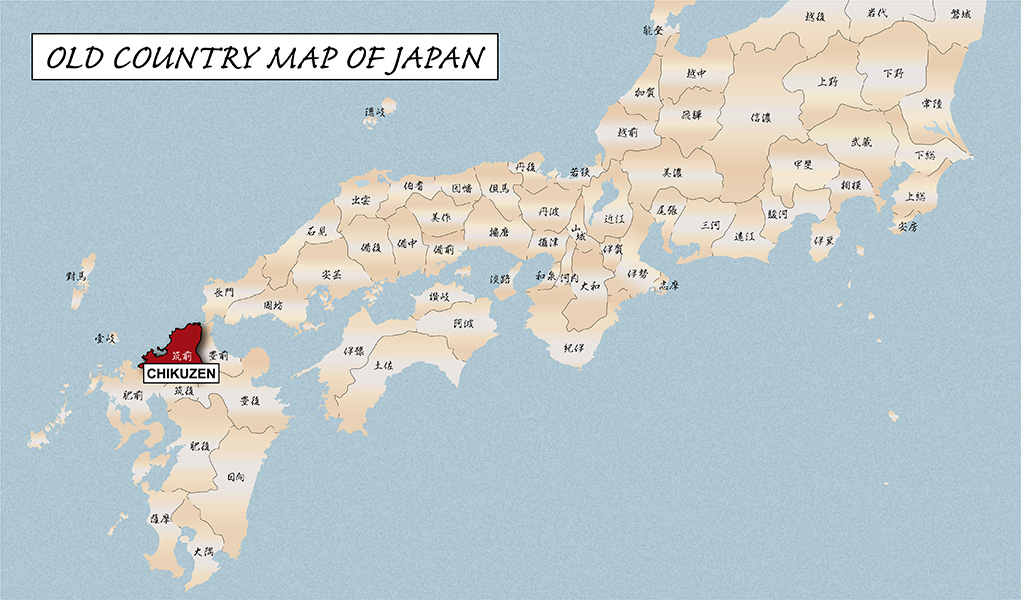
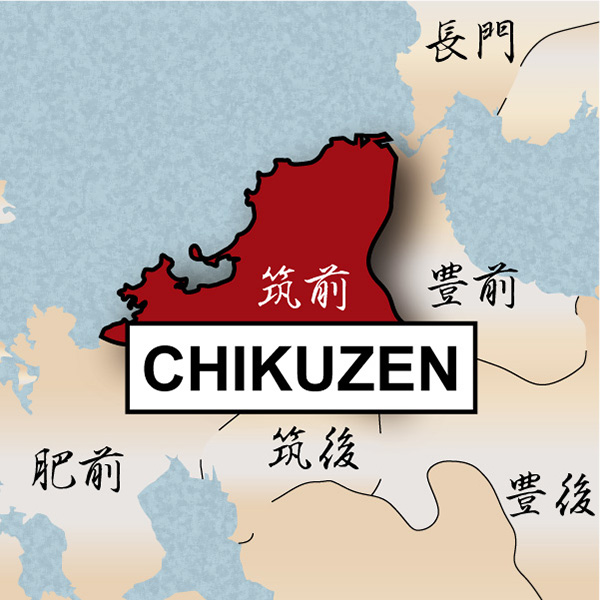
Yoshikuni was born in the second year of the Tensho era (1574) in Iwayo village in Oshu province (Today’s Fukushima prefecture). Some of his works have an engraving of the years the blades were made. This kind of work started from the 17th year of the Kan-Ei era (1640)to the third year of the Keian era (1650). There was a record of him forging a blade when he was 77 years old (1650). It is believed that during 1640-1650, his son, the second-gen Yoshikuni, often did a Daisaku for him. Daisaku is a regular act where an apprentice or a child of the swordsmith signs his master’s name with his master’s permission or forges a blade on behalf of the master. That means that Yoshikuni highly acknowledged his son’s craftsmanship.
Yoshikuni resided in Iwayo village in Oshu province (Today’s Fukushima prefecture) in his early career but was relocated to Yanagawa domain in Chikugo province (Today’s Fukuoka prefecture) by being summoned by Tachibana Muneshige (立花宗茂), who was the head of the domain. Tachibana Muneshige was an influential figure in this domain and one of the most famous warlords during the warring state period (Sengoku Jidai). Tachibana Muneshige used to rule the area where Yoshikuni lived, and we presume this is where Muneshige knew Yoshikuni’s reputation.
Yoshikuni is also known for forging very sharp swords, which made him and his work classified as Wazamono Toko( 業物刀工). Wazamono is a classification of Japanese swords and swordsmiths used in Japan to identify historic blades of exceptional quality in the book written by Kaiho Kenjaku ( 懐宝剣尺 ) in 1797.
Fujishiro Yoshio wrote a book called Token Jiten (Japanese Sword Dictionary). He is one of the most reputable Japanese sword experts in modern times. He categorized swordsmiths into five categories (Saijyo Saku, Jyojyo Saku Jyo Saku, Chu Jyo Saku, Chu Saku) regarding the reputation and skill of swordsmiths during the Shinto era (Early-Mid Edo period). Saijyo Saku is in the highest position. This chart often reflects how prominent a Japanese swordsmith is. Yoshikuni is categorized as a Jo Saku swordsmith.
This blade is appraised as a Hozon Touken (保存刀剣) issued by NBTHK (Nihon Bijutsu Touken Hozon Kyokai: 日本美術刀剣保存協会). This authentication paper was only given to authentic Japanese swords, well preserved and high quality with artistic value.
*Please keep in mind that there is a couple of Kitae Kizu on blade. If you like to see the detailed condition, please feel free to contact us.
【Blade】
Cutting Edge Length (Nagasa): 23.6 cm (9.29 inches)
Curvature (Sori): 0.0 cm (0.0 inches)

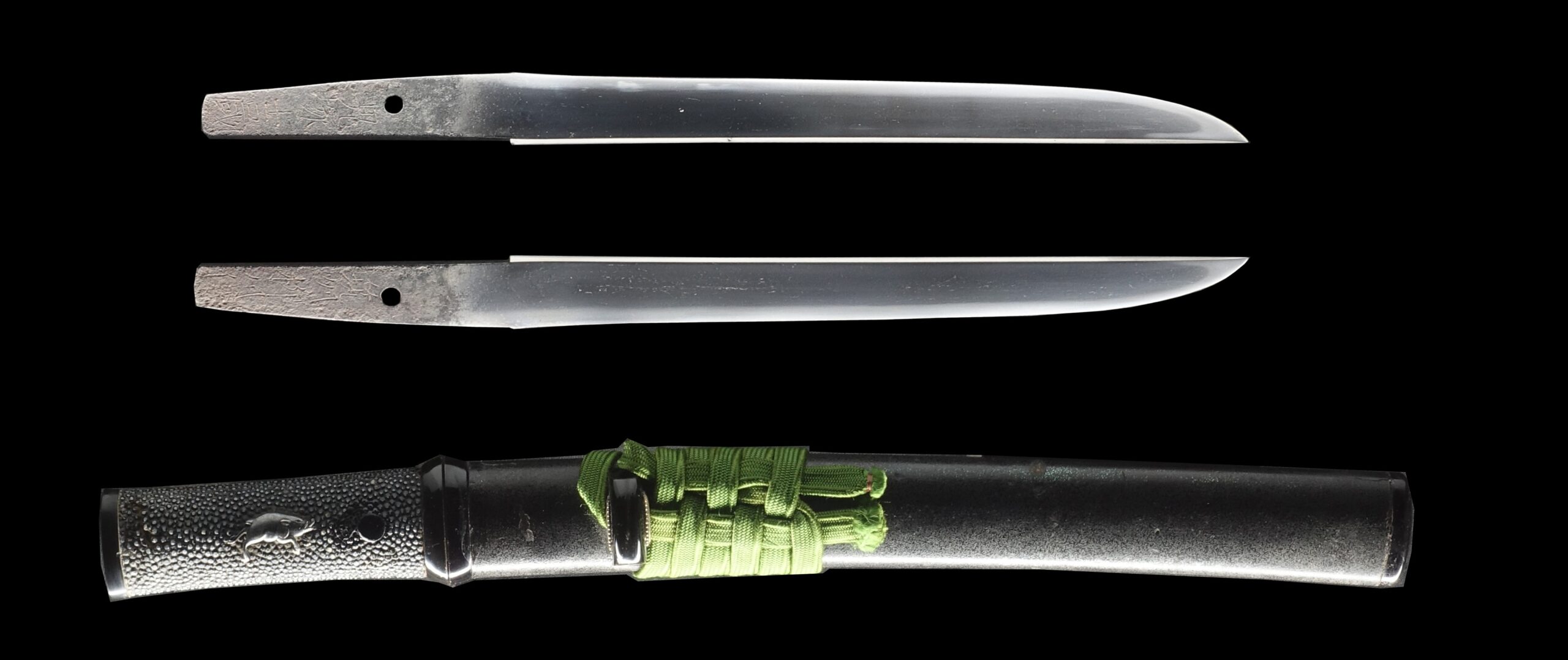
Hamon:
The crystalline structure which forms along the cutting edge of a blade as a result of the hardening process.
Jimon (Jihada):
Visible steel surface pattern created by folding and hammering during forging process.

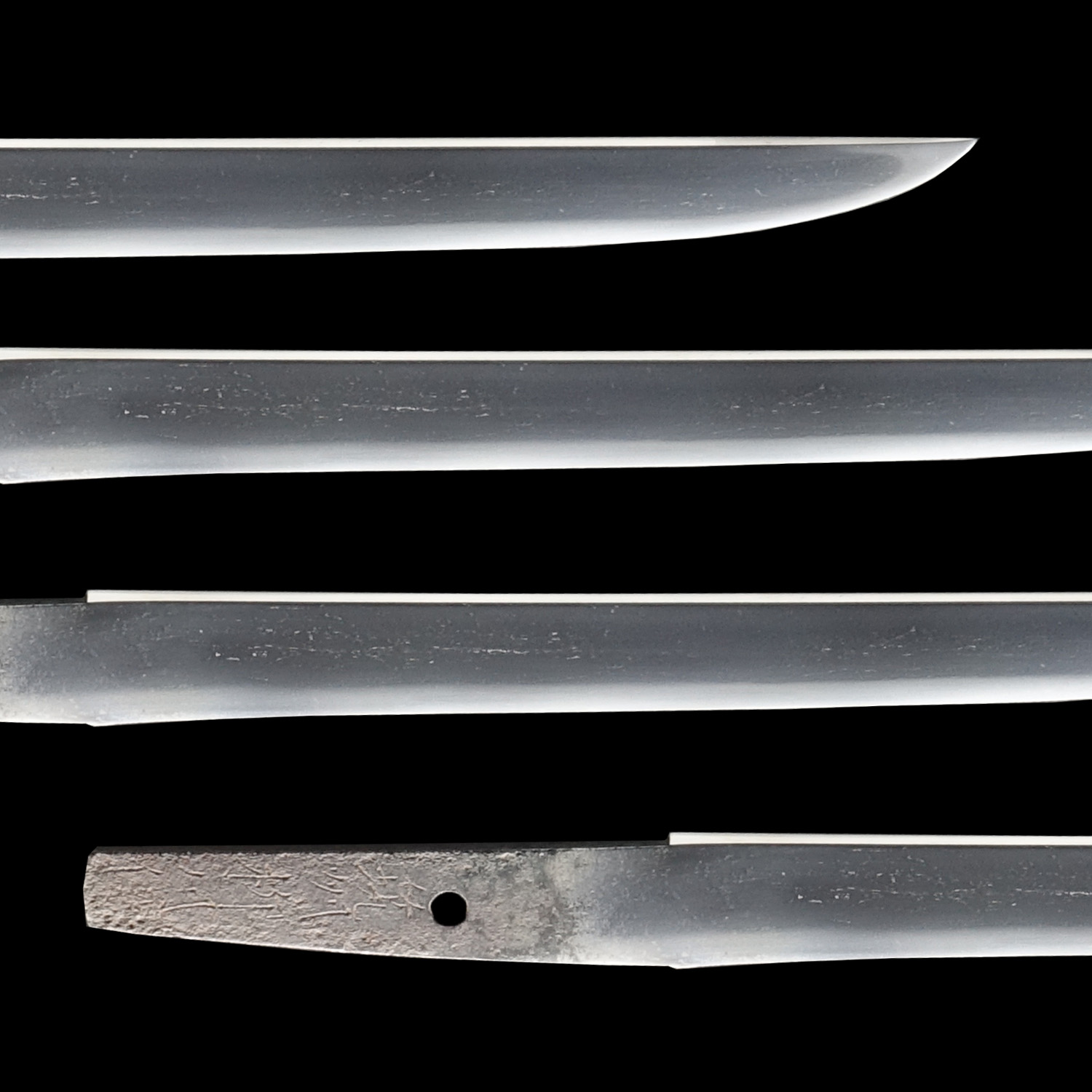
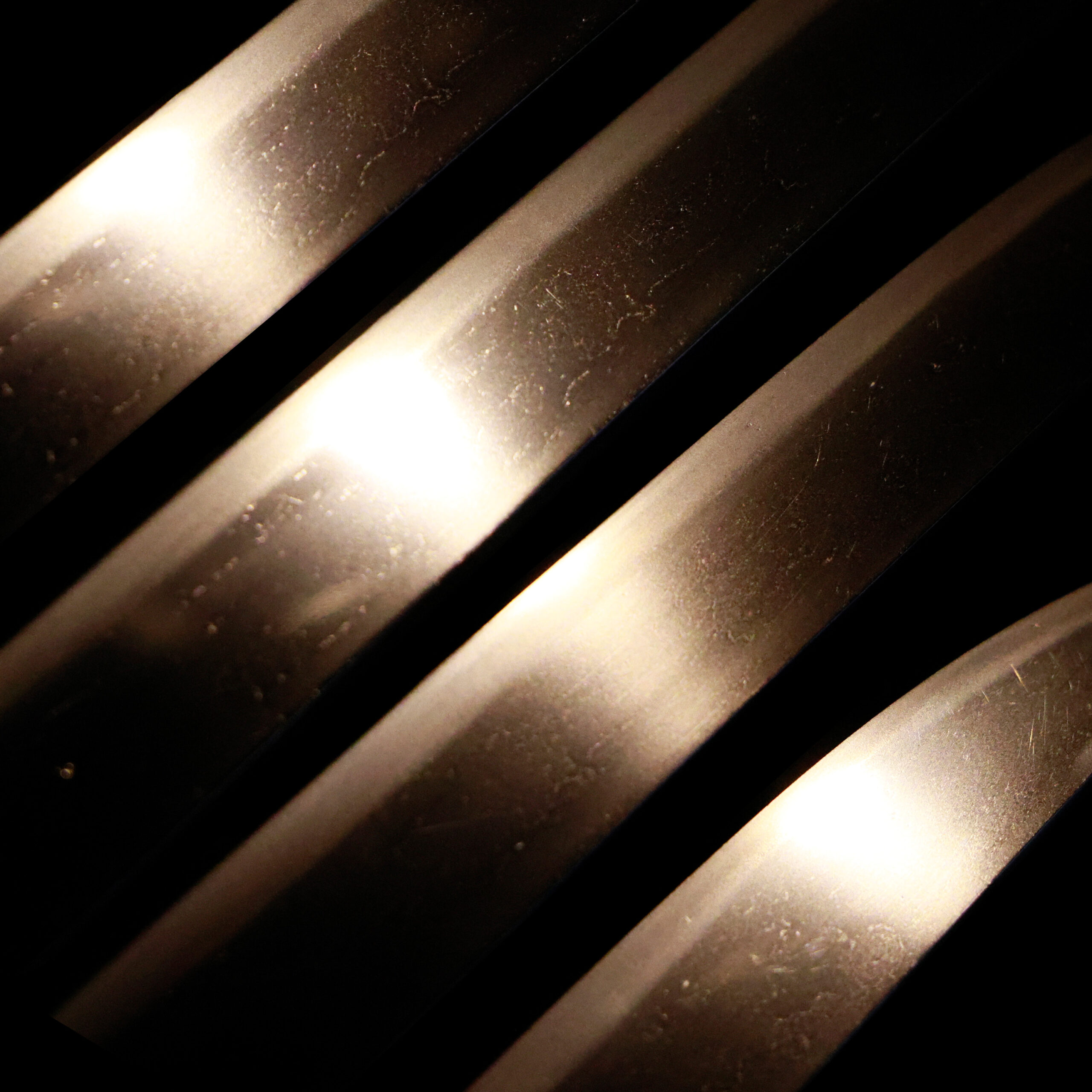
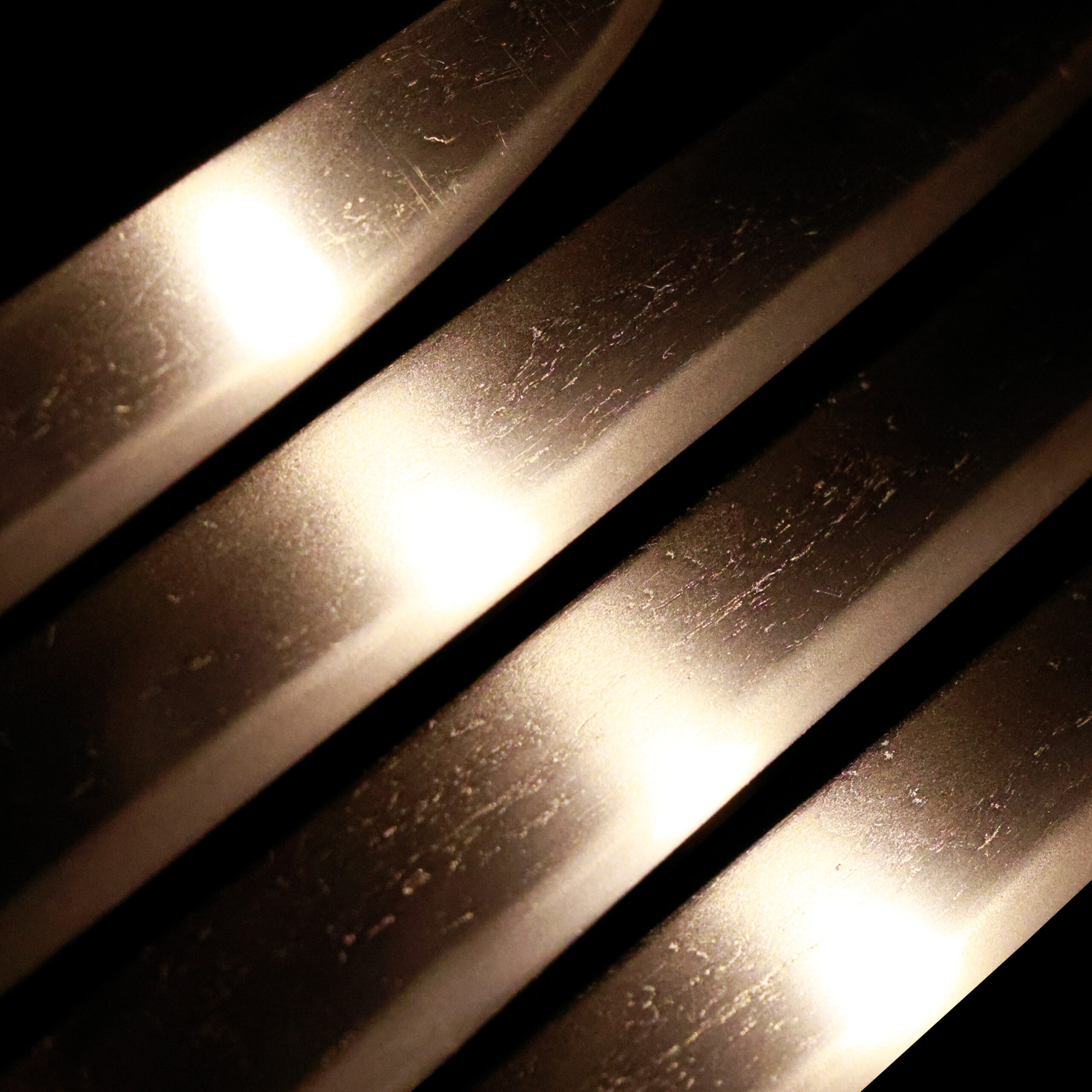


Kissaki: Kissaki is the tip of the Japanese sword.
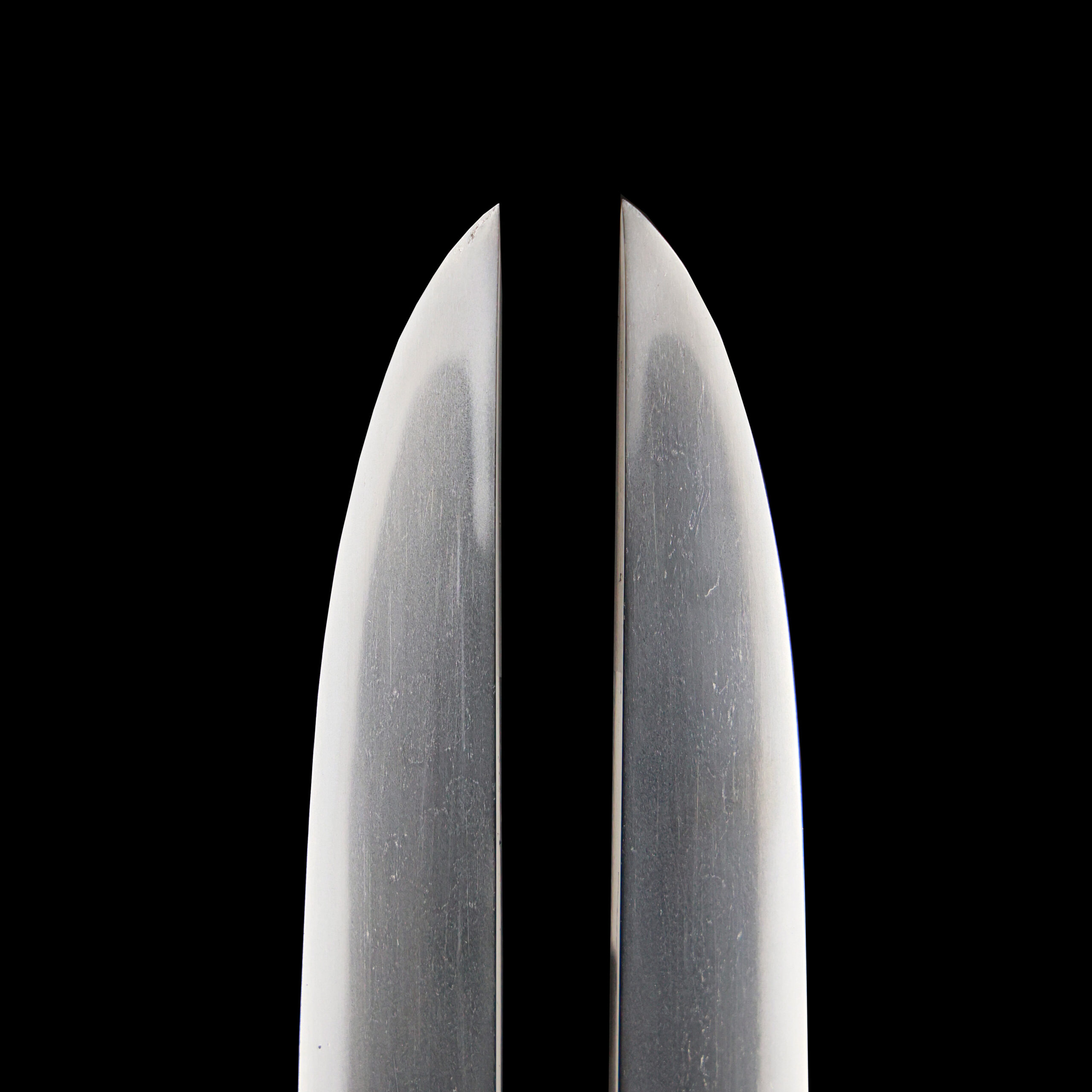
Nakago: Nakago is the tang of the Japanese sword.
Japanese swordsmiths left the black rust on the tang because it prevents red rust while the tang is in its handle. And the discoloration of the tang was created over time, and it is a great indicator for a Japanese sword specialist to estimate when the sword was forged.
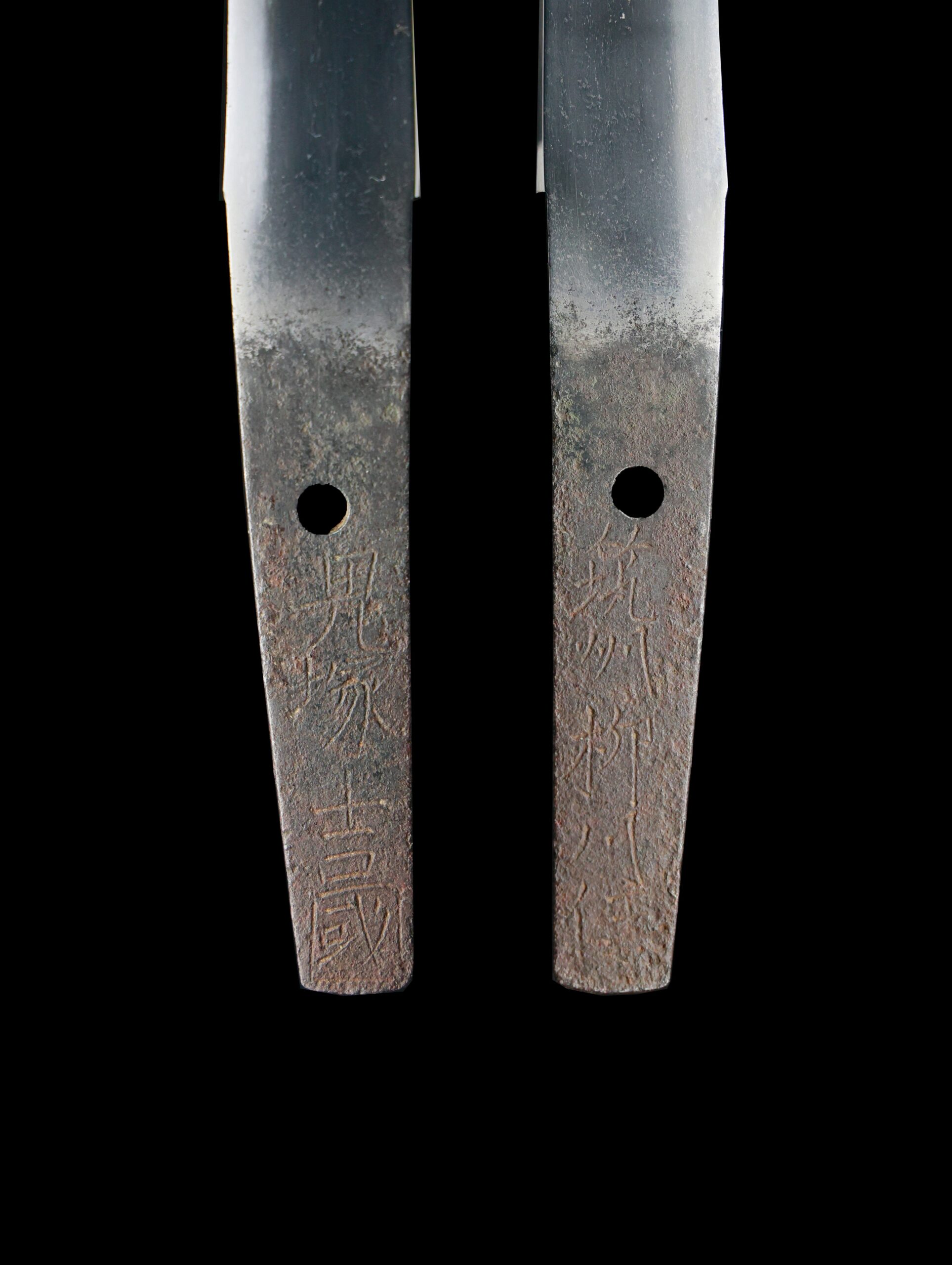
Koshirae: Koshirae is the mounting of the Japanese sword. There are several parts that consist of Koshirae such as Saya (Scabbard), Tsuka (Handle), Tsuba (Handguard).
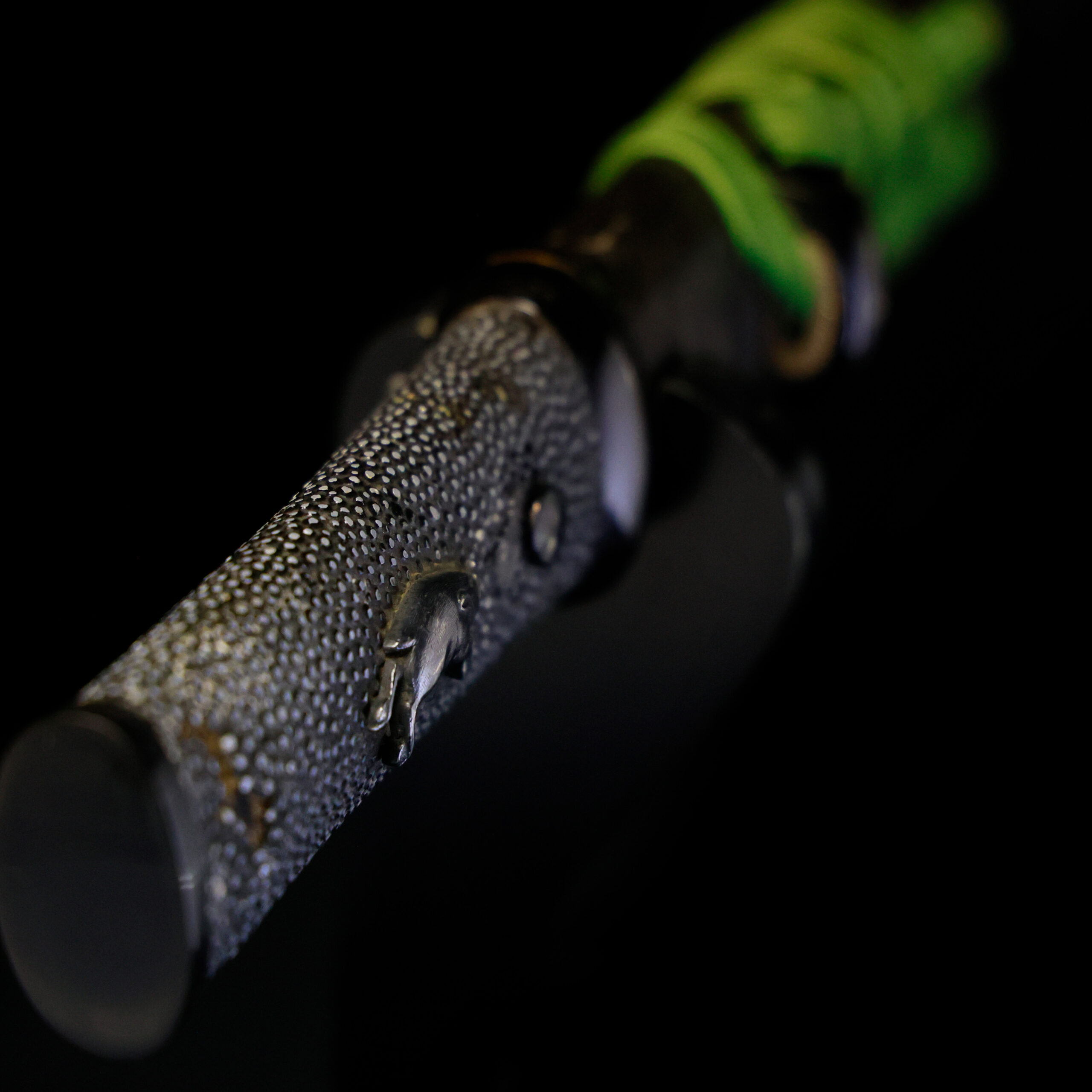
Fuchi-Kashira: A pair of matching sword fittings that cover the upper and bottom parts of its sword hilt.
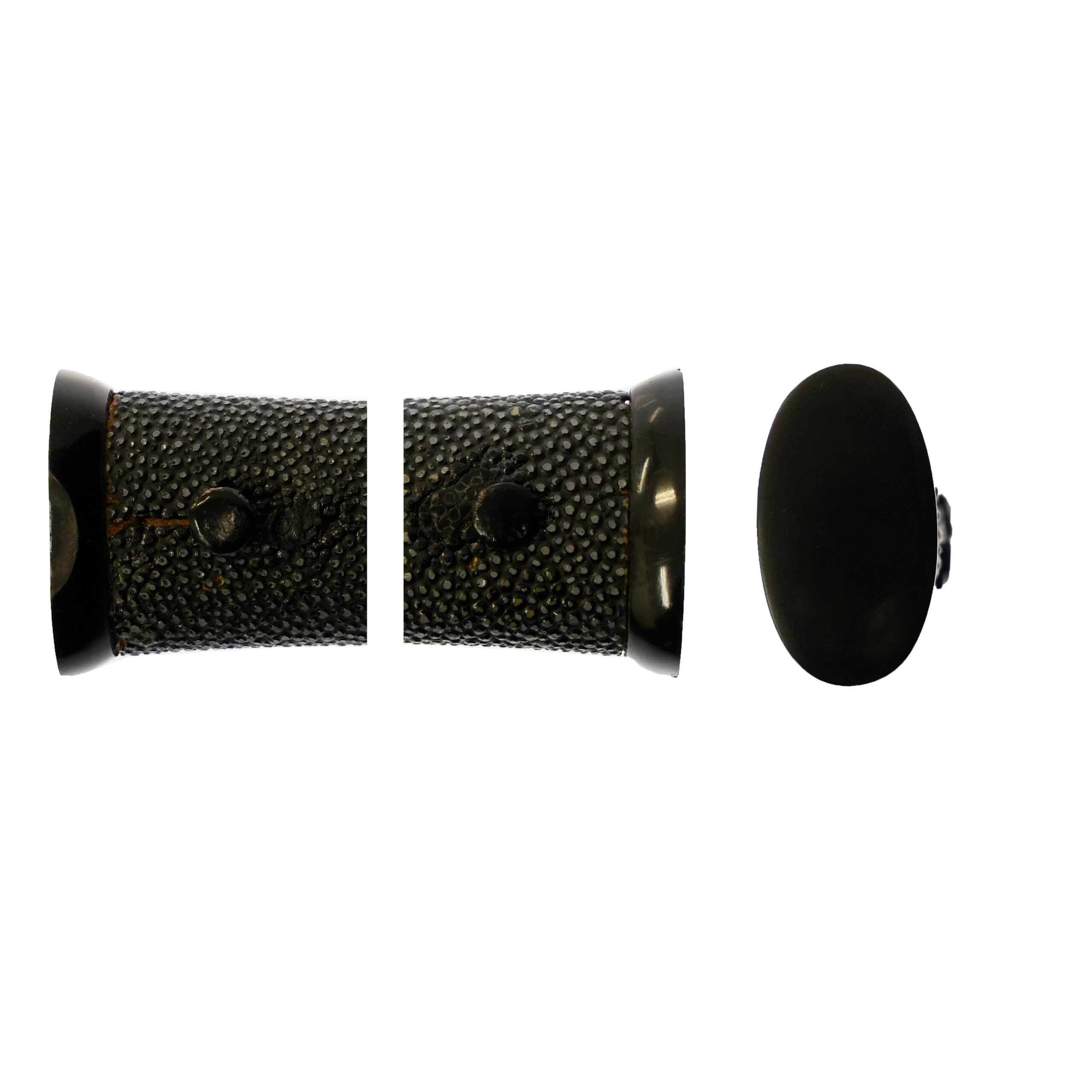
Tsuka and Menuki: Tsuka is the handle of the Japanese sword and Menuki is its decoration.
The design of this menuki features a wild boar (亥, inoshishi). In Japanese culture, the wild boar holds significant symbolic meaning and has appeared in folklore, art, and spiritual beliefs for centuries.
The wild boar is admired for its courage, determination, and fearlessness. It charges forward without hesitation, which has made it a symbol of bravery and unwavering will—qualities deeply respected by the samurai class. In traditional beliefs, the boar is also thought to ward off evil and bring protection, making it a fitting motif for sword fittings.
In the Japanese zodiac (十二支, Jūnishi), the boar represents one of the twelve animal signs and is associated with straightforwardness, honesty, and sincerity. It is also linked to prosperity and fertility in rural folklore, where the boar has been both hunted and revered.
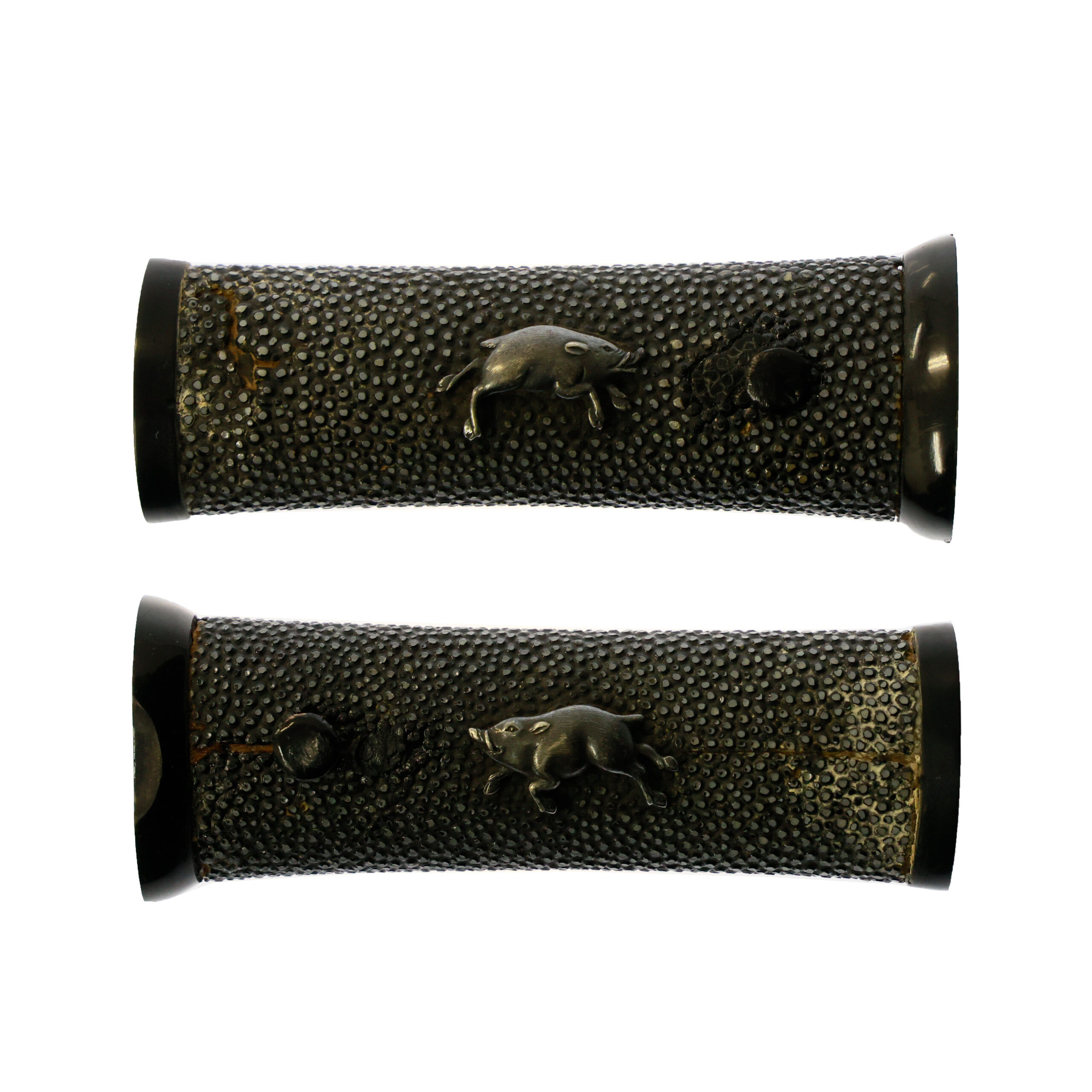
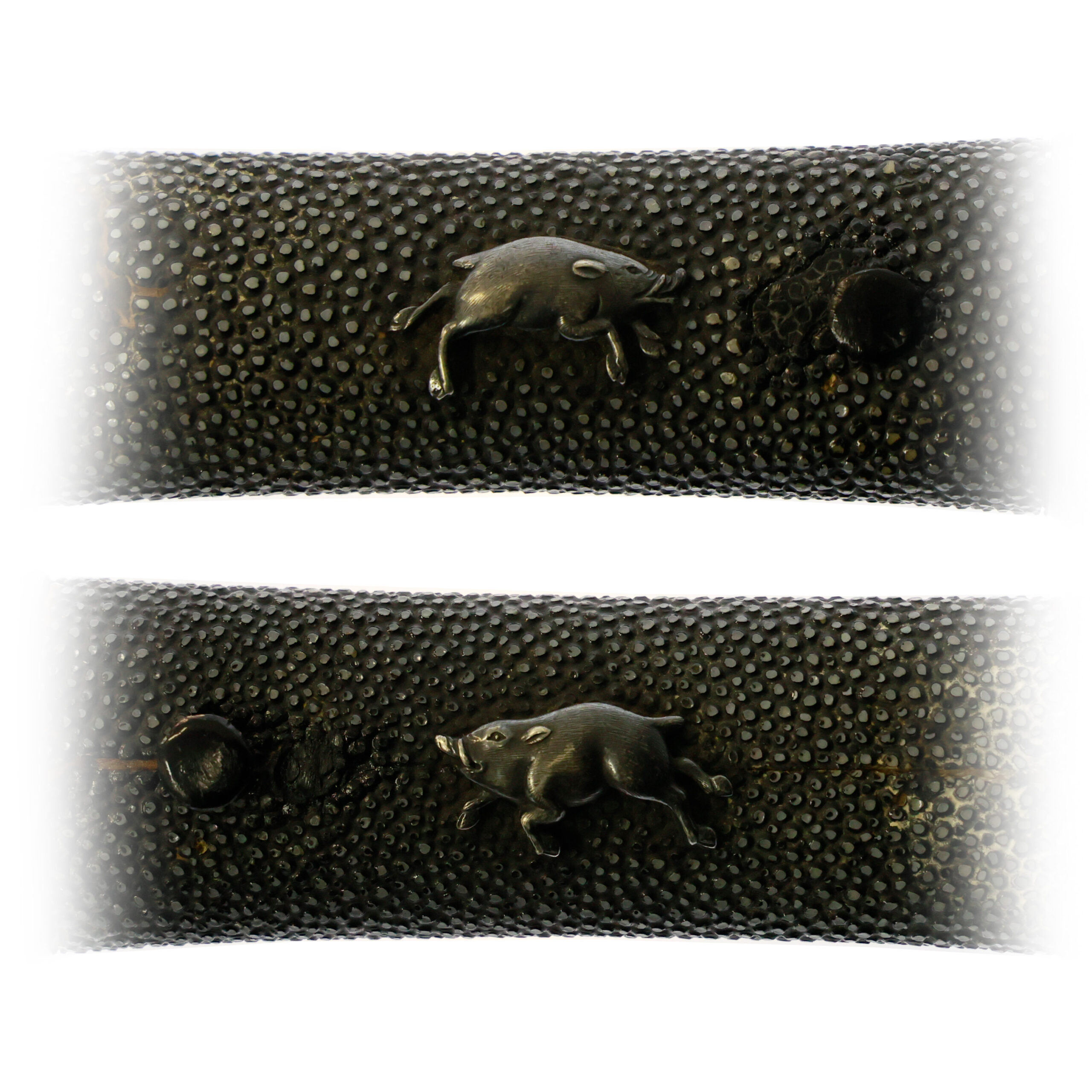
Tsuba and Habaki: Tsuba is the handguard for the Japanese Sword and Habaki is the equipment to make the blade not touch its scabbard inside. It prevents the blade from getting rusty and chipped.
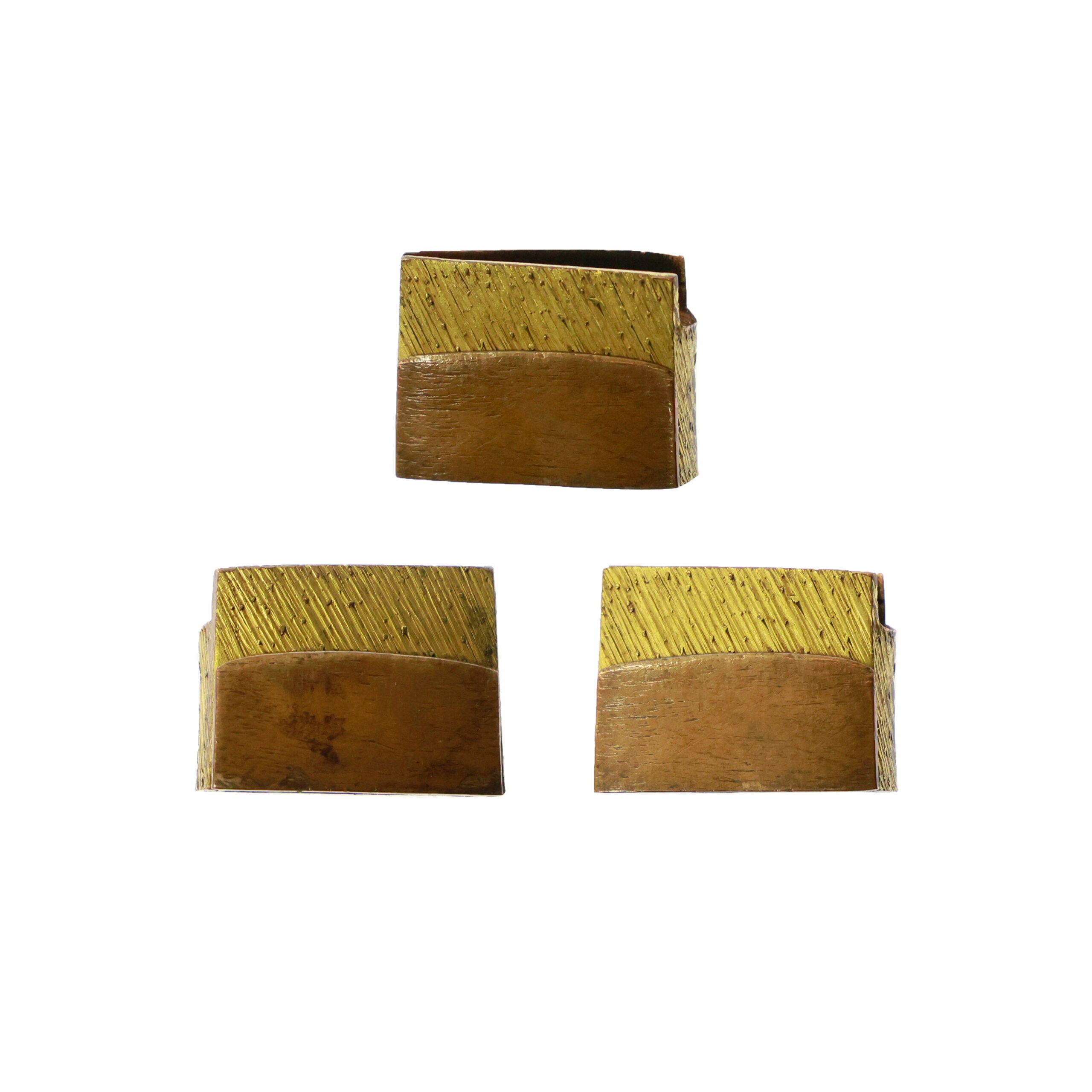
Kozuka: Kozuka is a small knife stored in Kozuka Hitsu(groove of the sheath of the Japanese sword).
The motif of this kozuka appears to depict kemari (蹴鞠), a traditional Japanese ball game with a history of over 1,400 years. It is said to have been introduced from China during the Asuka period and later developed into a refined courtly practice in Japan.
Kemari is a non-competitive game where the objective is not to win or lose, but to work together to keep a ball (mari) in the air for as long as possible by gently kicking it with the instep of the foot. The players form a circle and aim to pass the ball gracefully and cooperatively, focusing on elegance, rhythm, and teamwork.
The ball used in kemari is made of deerskin and stuffed with barley husks, and the players traditionally wear formal court garments called kariginu, along with eboshi caps. The refined and ritualistic nature of the game made it popular among the aristocracy, especially during the Heian period, and it was often performed as a cultural or ceremonial event rather than a sport.

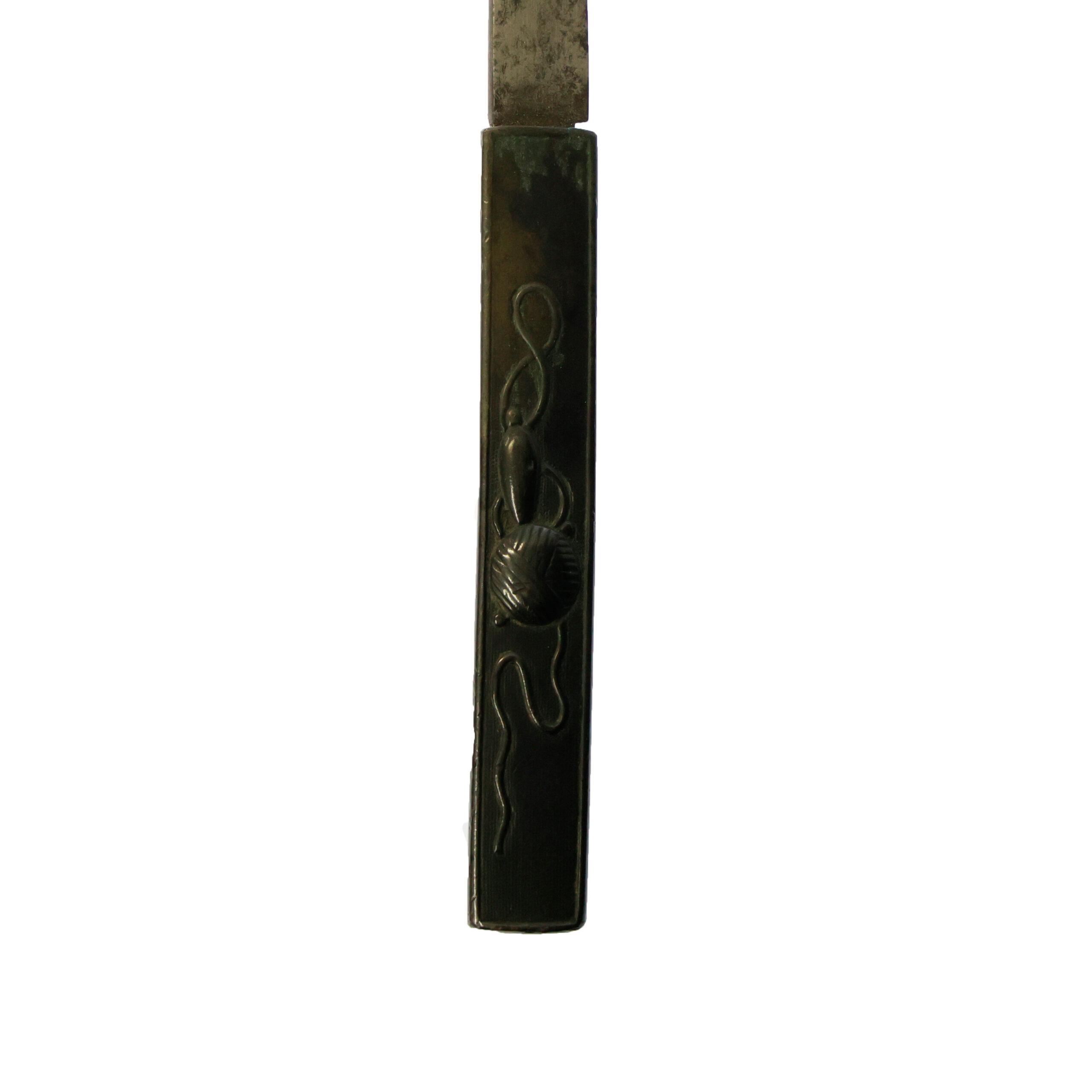
Saya: Saya is the scabbard for the Japanese sword
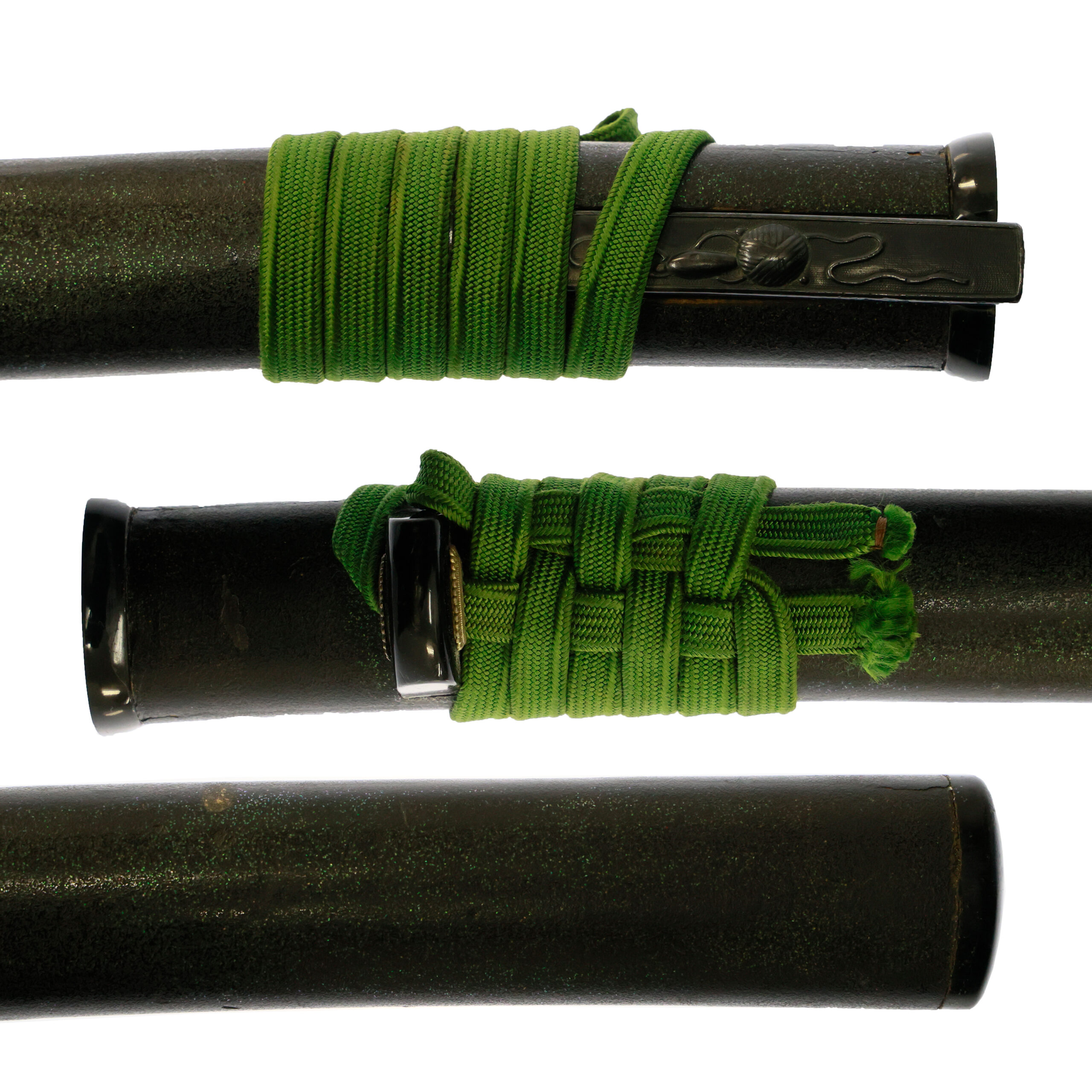
Authentication Paper: NBTHK Hozon Certificate for the blade (No.3034925)
NBTHK, also known as Nihon Bijutsu Touken Hozon Kyokai (the Society for the Preservation of the Japan Art Sword), is one of the oldest Japanese sword appraising organizations in modern-day Japan. They authenticated the blade on August 23rd in the 6th year of Reiwa (2024). They appraised it as Hozon Touken, the blade worth preserving for Japanese society. The purchaser will receive this original certificate as well. We can also translate what is written into English and make a PDF file for your record if you request.
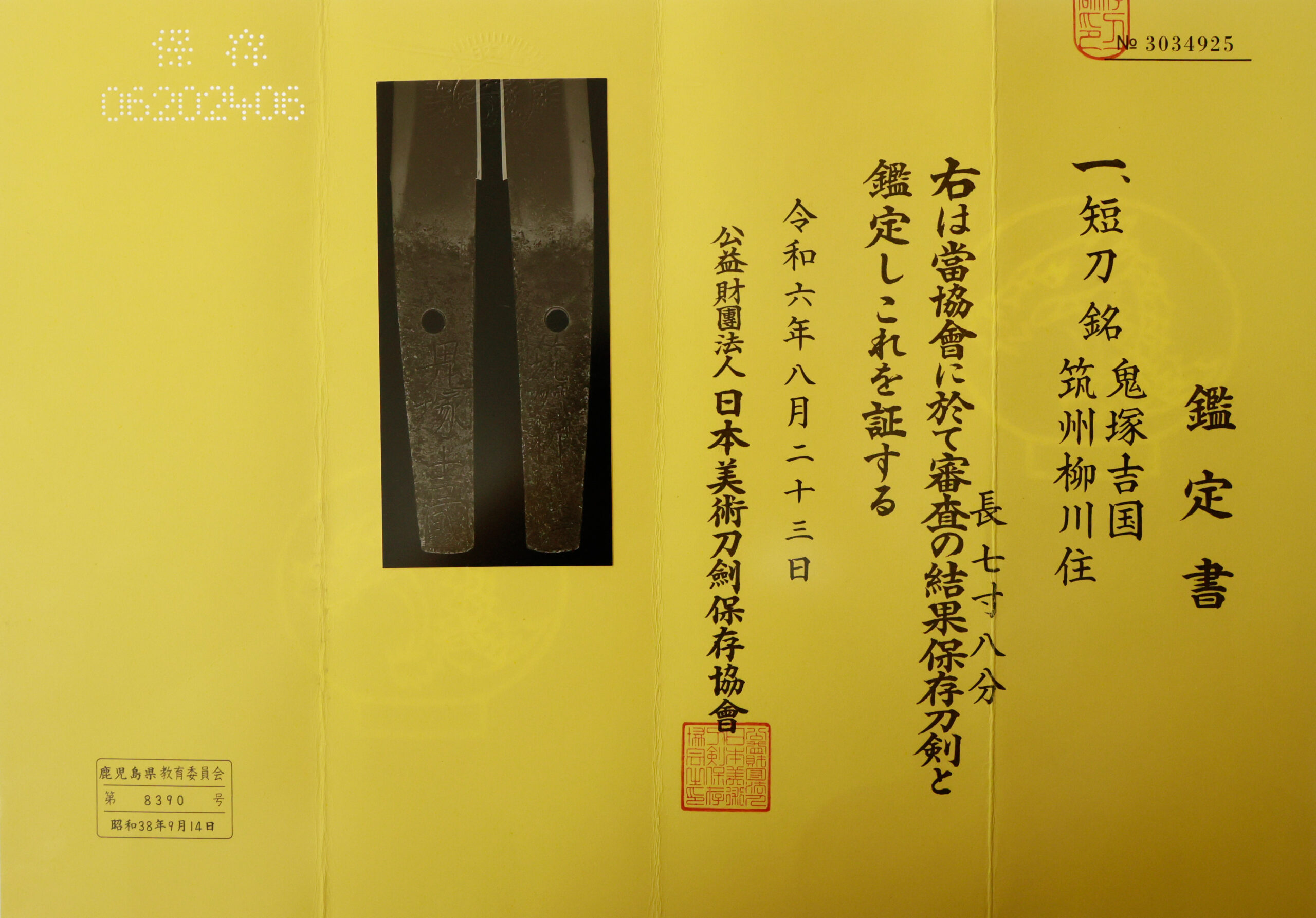
Registration Number: Kagoshima 8390
The Board of Education in Kagoshima prefecture issued a registration paper for this sword. It is called Jyu Hou Token Rui Torokusho (銃砲刀剣類登録証). Bunkacho (The Agency for Cultural Affairs) acknowledges a Japanese sword with this paper as a work of art.
The sword needs to be traditionally hand-forged and made of Tamahagane carbon steel to be registered in the system. With this paper, its owner in Japan can legally own an authentic Japanese sword. Based on this registration number, we will apply for its export permit.
This paper will need to be returned to the board of education when the sword is being shipped abroad, but you can receive a copy of it. An English translation of this registration paper is available on request.
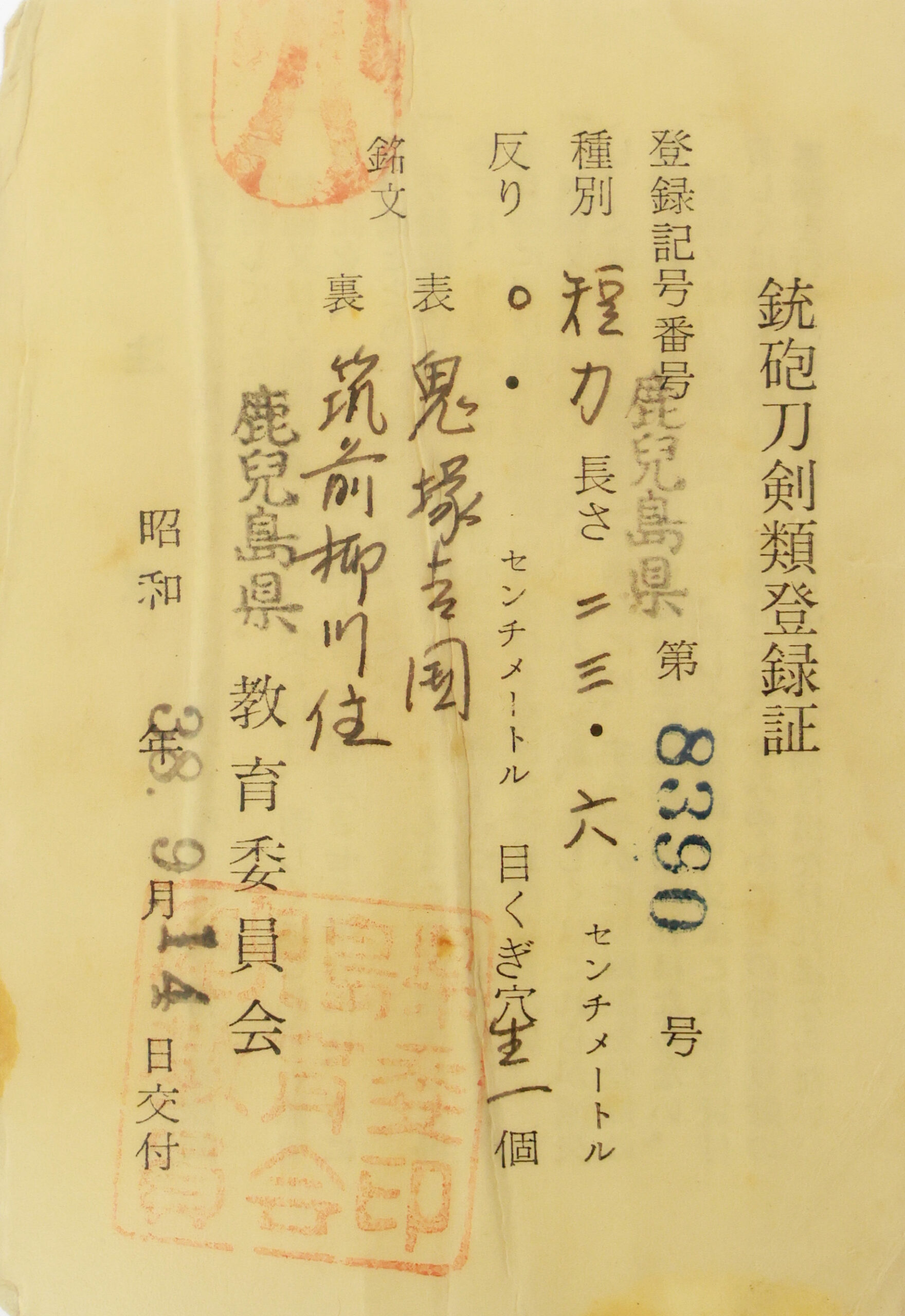
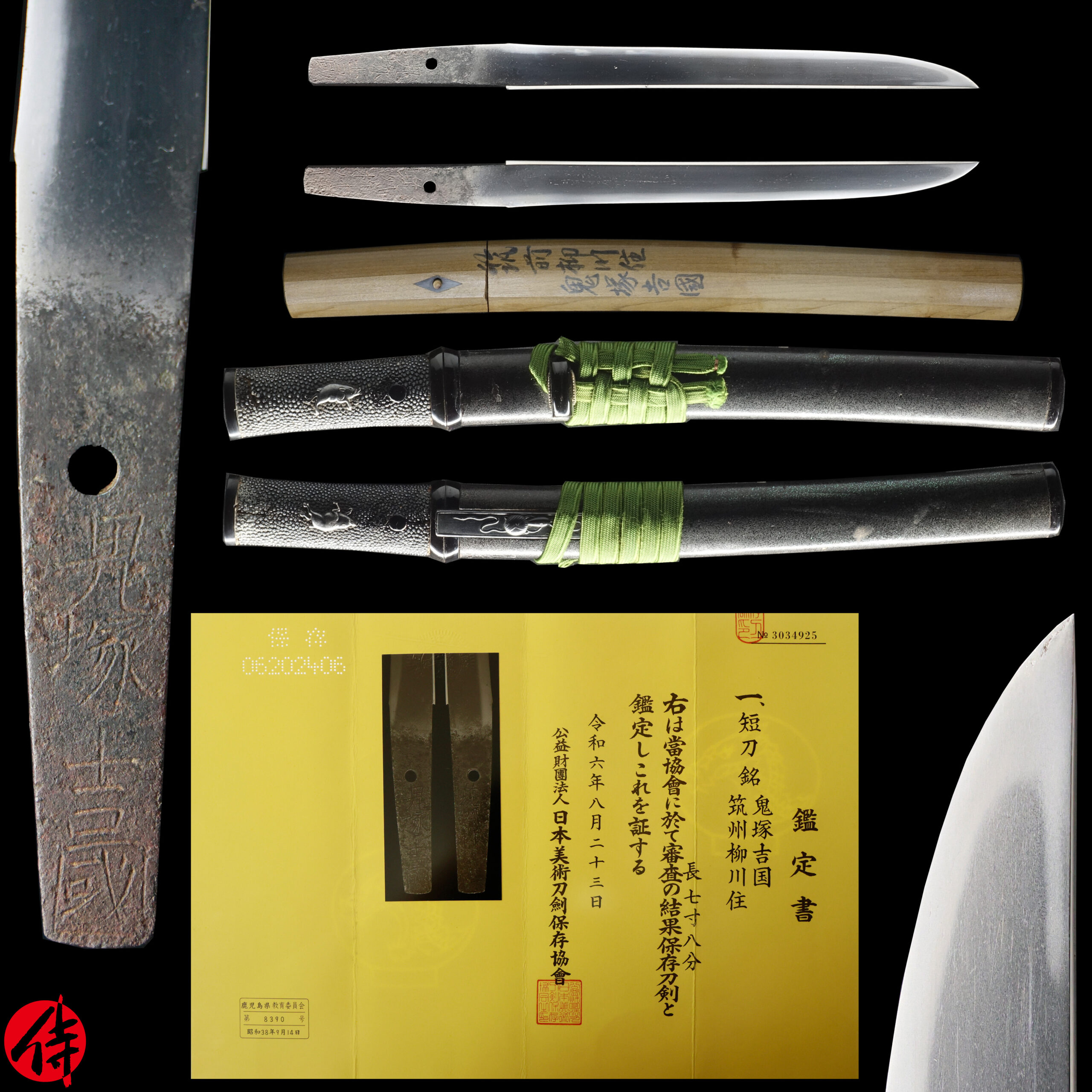
【About us】
Samurai Museum is located in Tokyo, Japan, exhibiting antique artifacts related to the Samurai history. Samurai Museum Shop is the place for those who are interested in Japanese culture and craftsmanship. We deal with antique Samurai swords/armor, traditional crafts made in Japan and so on.
【Japanese Sword& Export Process】
The Japanese swords we deal with are hand-forged edged swords made in Japan. It was made from the traditional carbon steel called TAMAHAGANE(玉鋼). Samurai Museum is familiar with the proper legal procedure for an antique/ authentic Japanese sword to be exported from Japan. We have sent more than 1000 Japanese swords for the past few years (~2025) to amazing owners who appreciate its historical value.
Each Japanese sword is registered under the Agency for Cultural Affairs and the Board of Education in Japan. They issue a registration paper for each Japanese sword for its owner in Japan to legally possess it. The Japanese sword with its registration paper means it was traditionally hand-forged in Japan.
To legally export the sword from Japan to other countries, we will have to apply for its permit to the Agency for Cultural Affairs(Bunkacho) and return the original registration paper to the Board of Education. It normally takes around 2-4 weeks to receive this permit after submitting required documents. And we would like you to expect at least 1-1.5 months for your order to arrive at your given address after you ordered. For more detailed info, please click here.
It is allowed for residents in Japan to own authentic Japanese swords without a special license as long as they come with registration papers. Please feel free to contact us if you are a resident of Japan, whether temporarily or permanently. We will also assist you when you leave Japan and need to obtain the export permit.
【Payment Method】
We accept payment through Stripe (Credit card), PayPal, Apple Pay or ChromePay, all of which are secure payment methods. Also, you don’t need to make an account on Stripe for the checkout. If you prefer other payment method, please contact us. After confirming your payment, we will apply for an export permit. You may either pay in JPY, USD, AUD, CAD,EUR CHF or GBP. The price is set in Japanese Yen. Prices in other currencies are automatically calculated based on the latest exchange rate.

* If the amount is above 1 million JPY, Stripe or wire transfer will be the only options for payment.
【Shipping】
We have shipped authentic Japanese swords to the USA, Canada, Mexico, Germany , Belgium, France, Finland, UK, Hong Kong, Australia. If you don’t live in these countries and like to order, please contact us first before making a purchase. We offer Free International Shipping as long as we can send antique Japanese swords by EMS.
We normally ship by EMS(Express Mail Service) provided by Japan Post. We will send you a tracking number for your order as soon as we hand it to the post office. We will put 100 % insurance on the shipping document without any extra charge. Based on the total amount, there might be a duty tax or other fee for you to pay, depending on the countries. We use package cushioning to protect the item and put it in a PVC pipe, which is one of the most secure packages because of its durability.
It will normally takes 5-14 days for the item to arrive at your given address after we dispatch it. Time of delivery is estimated as accurately as possible by the carrier but does not take into account any delays beyond our control such as by inclement weather, post office holiday seasons.
* If you live in Australia and like to purchase an authentic Japanese sword, please click here to know the detail.
* If you live in the UK and like to purchase an authentic Japanese sword, please contact us first and click here to know the detail.

【Review】
Here is one of the reviews we received from a customer who purchased an authentic Japanese sword from us. For more reviews, please click here.
“My experience overall with the whole process was wonderful. I had many questions about the history and process to purchase these treasures. All my questions were answered very timely and complete. The staff is very knowledgeable and very well versed if any questions do arise.”
【How to make sure the condition】
Please keep in mind that what you are going to purchase is an antique item. We uploaded high resolution photos for you to check its condition thoroughly. If you like to see more photos with different angles, please feel free to contact us. We will be happy to send them to you so that you can make informed decision. It is essential for us to know that you are happy with your choice of a sword. and we are prepared to use the best of our ability to serve you.
【How To Contact Us】
Please contact us through email, Facebook Messenger or Live Chat if you have any questions. You can find each icon on the right side of the website. Please click one of them to reach us. We will reply to you within 1-2 business days.
【The Art of Nihonto (Japanese Sword)】
Samurai’s history is a profound, eloquent legacy of ancient Japanese warriors in which millions of people worldwide are being fascinated. If you like to find out the art of Nihonto, please click here.
【A Guide to Japanese Sword Maintenance】
After acquiring an genuine Japanese sword, it is also important to know how to take good care of it. Here is the special video for you. Mr. Paul Martin, Japanese sword expert, shows you how to give proper maintenance to your sword. By mastering how to clean the Japanese sword, its aesthetic beauty will last forever.
When you purchase a Japanese sword from us, you can get a Free Japanese sword maintenance kit. It comes with four tools(Choji Oil, Uchiko Whetstone Powder, Peg remover, Oil Applicator). By watching the video instruction above , you can enjoy learning how to maintain your Japanese sword while appreciating it. If you have any difficulty assembling the sword or cleaning the blade, you can feel free to contact us.
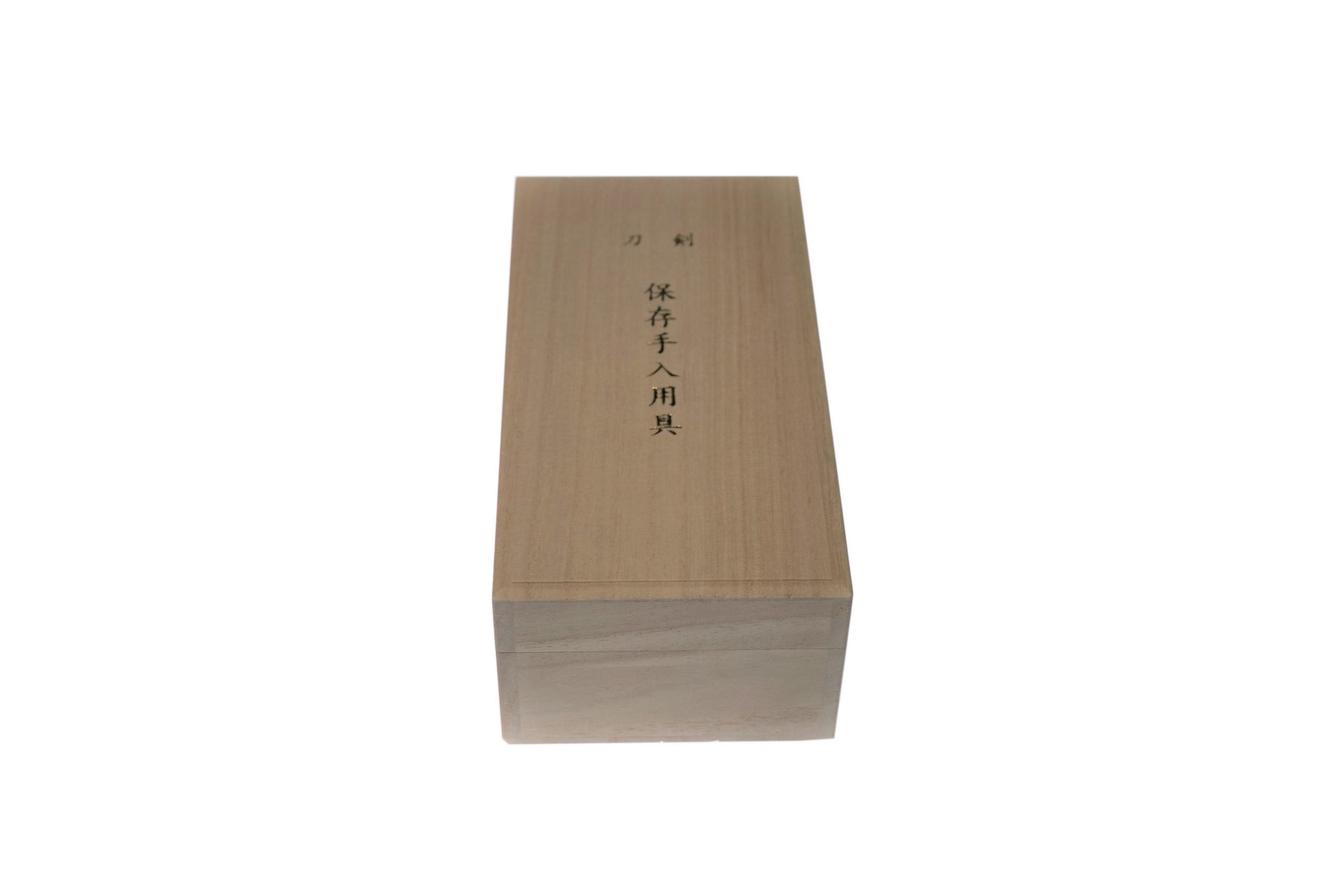
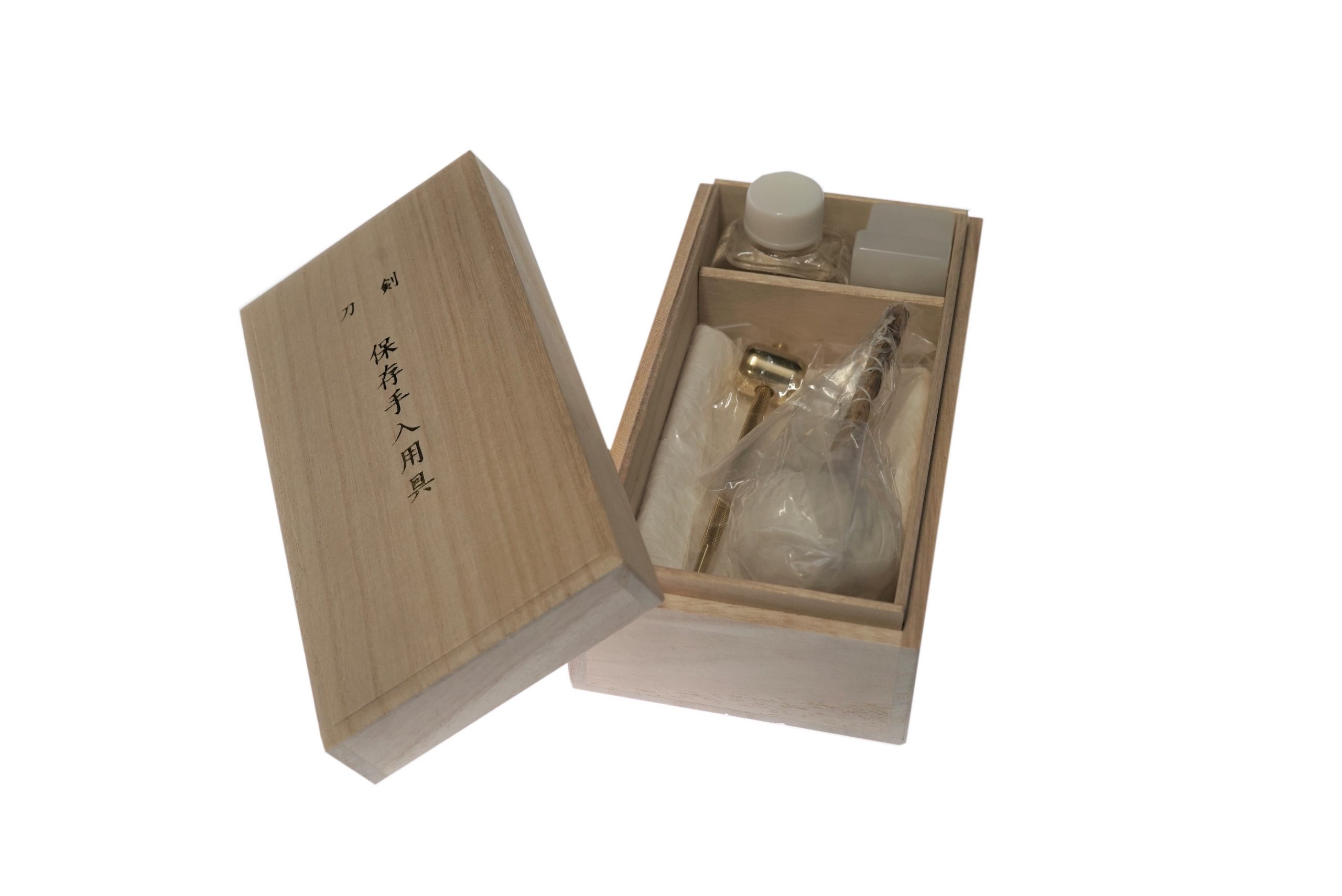
MORE ANTIQUE JAPANESE SWORD FOR SALE
SWORDS WITHOUT CERTIFICATES FOR SALE
LEARN JAPANESE SWORD TERMINOLOGY
Thank you for reading all the information on the page. If you have any difficulty choosing the right Japanese sword for you, we will be more than happy to help you find the one that speaks to you the most. Please feel free to contact us.
